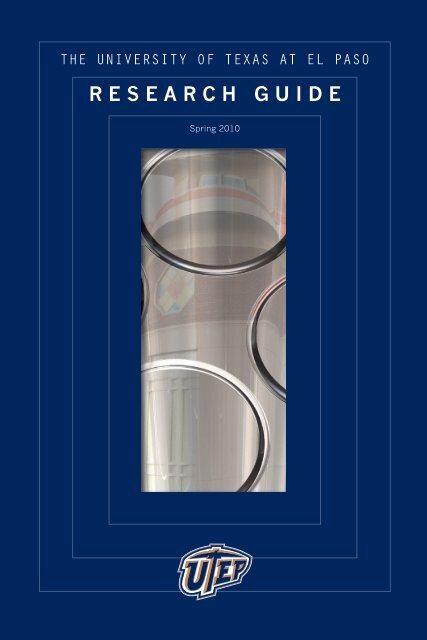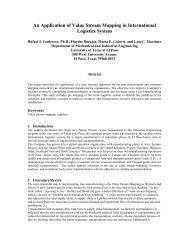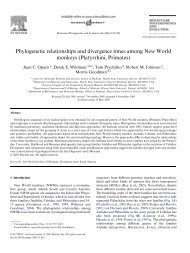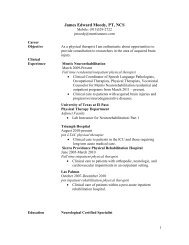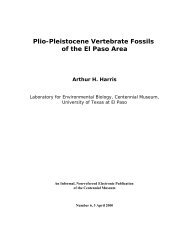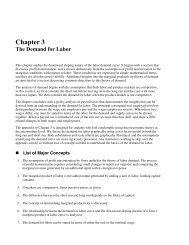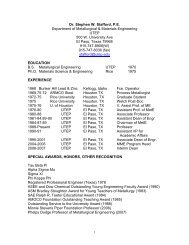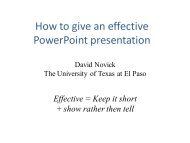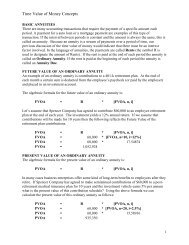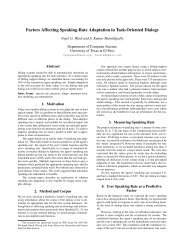The University of Texas at El Paso - UTEP Magazine
The University of Texas at El Paso - UTEP Magazine
The University of Texas at El Paso - UTEP Magazine
You also want an ePaper? Increase the reach of your titles
YUMPU automatically turns print PDFs into web optimized ePapers that Google loves.
<strong>The</strong> <strong>University</strong> <strong>of</strong> <strong>Texas</strong> <strong>at</strong> <strong>El</strong> <strong>Paso</strong>r e s e a r c h g u i d eSpring 2010
INSIDE2 <strong>UTEP</strong> Fast Facts4 Overview6 About This Guide8 Tier One12 Biomedical Engineering16 Biomedical Sciences22 Comput<strong>at</strong>ional Science24 Defense Research28 Educ<strong>at</strong>ion Innov<strong>at</strong>ions36 Environmental Scienceand ResourceManagement40 Geological Sciences44 Health Sciences48 M<strong>at</strong>erials Engineering54 Transport<strong>at</strong>ion56 Programs Inspire NewResearchers59 Future Facilities <strong>of</strong> <strong>UTEP</strong>Research Programs60 President, Provost/VicePresident for AcademicAffairs,Vice Presidentfor Research andCollege DeansResearch Guide | 1
<strong>UTEP</strong> <strong>of</strong>fers 79 bachelor’s degrees, 86 master’s degrees and 16 doctor<strong>at</strong>es—with more in development. <strong>UTEP</strong> also<strong>of</strong>fers cooper<strong>at</strong>ive Ph.D. programs in pharmacy and nursing with UT Austin and the UT Health Sciences Center <strong>at</strong>Houston.<strong>UTEP</strong> is a key economic force in the <strong>Paso</strong> del Norte region th<strong>at</strong> includes West <strong>Texas</strong>, Southern New Mexico andNorthern Mexico. <strong>UTEP</strong>’s oper<strong>at</strong>ing budget for FY09-10 is $355 million. According to the <strong>UTEP</strong> Institute for Policyand Economic Development, the <strong>University</strong>’s contribution to the personal income <strong>of</strong> local individuals in the region is$343 million, and the number <strong>of</strong> jobs <strong>at</strong>tributed to <strong>UTEP</strong>’s presence totals 6,123.On the playing field, the <strong>UTEP</strong> Miners compete in Division 1 sports as a member <strong>of</strong> Conference USA’s West Division.<strong>UTEP</strong> is home to the 51,500-se<strong>at</strong> Sun Bowl Stadium and the 12,222-se<strong>at</strong> Don Haskins Center, named for thelegendary coach who, in 1966, delivered <strong>Texas</strong>’ only Division I Men’s Basketball Championship.In the 2008-09 academic year, the <strong>University</strong> embarked on an unprecedented $250 million program <strong>of</strong> newconstruction and renov<strong>at</strong>ion projects, including a teaching and research building for chemistry and computerscience; a facility for the College <strong>of</strong> Health Sciences and the School <strong>of</strong> Nursing; a new <strong>University</strong> Bookstore and theFoster Stevens Basketball Complex.<strong>UTEP</strong> has nearly 1,200 faculty, and one <strong>of</strong> the highest percentages <strong>of</strong> minority faculty among universities in theUnited St<strong>at</strong>es—more than 30 percent.Research Guide | 3
Overview4 | <strong>The</strong> <strong>University</strong> <strong>of</strong> <strong>Texas</strong> <strong>at</strong> <strong>El</strong> <strong>Paso</strong>
the university <strong>of</strong> texas <strong>at</strong> el paso<strong>The</strong> <strong>University</strong> <strong>of</strong> <strong>Texas</strong> <strong>at</strong> <strong>El</strong> <strong>Paso</strong> isloc<strong>at</strong>ed in <strong>El</strong> <strong>Paso</strong>, <strong>Texas</strong>, on the northernbank <strong>of</strong> the Rio Grande along theU.S.-Mexico border. <strong>UTEP</strong> students liveand study in one <strong>of</strong> the world’s largestbin<strong>at</strong>ional metropolitan areas, pursuingcultural, social and academic opportunitiesnot available on most universitycampuses.<strong>UTEP</strong> has been a cornerstone <strong>of</strong> the <strong>El</strong><strong>Paso</strong> community since it was founded asthe <strong>Texas</strong> School <strong>of</strong> Mines and Metallurgyalmost 100 years ago.In 1914, the school opened with 27students and a handful <strong>of</strong> faculty andstaff. From this modest beginning, <strong>UTEP</strong>has grown into a dynamic urban universityth<strong>at</strong> serves the needs <strong>of</strong> more than21,000 students.Nearly 76 percent <strong>of</strong> <strong>UTEP</strong>’s studentpopul<strong>at</strong>ion is Mexican-American. In recognition<strong>of</strong> the <strong>University</strong>’s success incre<strong>at</strong>ing educ<strong>at</strong>ional opportunities fornontraditional students, the N<strong>at</strong>ional ScienceFound<strong>at</strong>ion design<strong>at</strong>ed <strong>UTEP</strong> as aModel Institution for Excellence, one <strong>of</strong>only six in the country. This has resultedin a multimillion-dollar NSF grant to support<strong>UTEP</strong>’s science, computer science,engineering and m<strong>at</strong>hem<strong>at</strong>ics programs.Capitalizing on the <strong>University</strong>’s bordersetting, faculty research focuses on areassuch as biomedicine, environmental scienceand engineering, and manufacturingengineering. Research expenditurestotaled more than $50 million in 2008,the last year for which compar<strong>at</strong>ive figuresare available. <strong>The</strong> <strong>University</strong>’s undergradu<strong>at</strong>estudents particip<strong>at</strong>e in hands-onresearch, working <strong>at</strong> a pr<strong>of</strong>essional levelunheard <strong>of</strong> <strong>at</strong> other universities. Studentsalso have many opportunities to particip<strong>at</strong>ein bin<strong>at</strong>ional research programs between<strong>UTEP</strong> and higher educ<strong>at</strong>ion institutionsin Mexico.To expand its research capabilities,<strong>UTEP</strong> has embarked on an unprecedented$250 million program <strong>of</strong> new constructionand renov<strong>at</strong>ion projects, the mostsignificant single campus transform<strong>at</strong>ionin its history. New construction includes <strong>at</strong>eaching/research building for chemistryand computer science and expansion <strong>of</strong>the science and engineering complex aswell as a new $60 million facility for theCollege <strong>of</strong> Health Sciences and School <strong>of</strong>Nursing.<strong>UTEP</strong>’s achievements extend far beyondits traditional strengths in scienceand engineering. <strong>The</strong> <strong>University</strong> has receivedn<strong>at</strong>ional acclaim for innov<strong>at</strong>iveprograms in business, fine arts, educ<strong>at</strong>ion,humanities and health sciences.<strong>The</strong> Carnegie Found<strong>at</strong>ion ranks <strong>UTEP</strong>as a doctor<strong>at</strong>e-granting university withhigh research activity, placing the <strong>University</strong>among the top 7 percent <strong>of</strong> allcolleges and universities in the UnitedSt<strong>at</strong>es. This classific<strong>at</strong>ion reflects <strong>UTEP</strong>’ssuccess in providing its students with opportunitiesto pursue advanced degreesin a broad range <strong>of</strong> fields. Today, the<strong>University</strong> <strong>of</strong>fers 16 doctoral degree programs,and two more—in nursing andpharmacy—through cooper<strong>at</strong>ive programswith UT Austin and the UT HealthScience Center <strong>at</strong> Houston.Proposals for new doctoral programs,including a Ph.D. in Ecology and EvolutionaryBiology and Doctors <strong>of</strong> NursingPractice, Physical <strong>The</strong>rapy, and PublicAdministr<strong>at</strong>ion degrees, have been sentto the UT System and the Higher Educ<strong>at</strong>ionCoordin<strong>at</strong>ing Board for review.Research Guide | 5
About This Guide6 | <strong>The</strong> <strong>University</strong> <strong>of</strong> <strong>Texas</strong> <strong>at</strong> <strong>El</strong> <strong>Paso</strong>
NewAEra <strong>of</strong>ResearchAn exciting era <strong>of</strong> discovery and innov<strong>at</strong>ion is under way <strong>at</strong><strong>The</strong> <strong>University</strong> <strong>of</strong> <strong>Texas</strong> <strong>at</strong> <strong>El</strong> <strong>Paso</strong>.At <strong>UTEP</strong>’s st<strong>at</strong>e-<strong>of</strong>-the-art Bioscience Research Building,researchers are advancing the field <strong>of</strong> “personalizedmedicine” by studying genetic targets for tre<strong>at</strong>ment <strong>of</strong> cancerwww.utep.eduthe university <strong>of</strong> texas <strong>at</strong> el pasoand infectious diseases. Inside the walls <strong>of</strong> the College <strong>of</strong>Engineering, the field <strong>of</strong> bioengineering is flourishing asengineers, biologists and physicians collabor<strong>at</strong>e on projectsinvolving engineered tissue, novel medical devices andcutting-edge imaging technologies.And the future looks bright as <strong>UTEP</strong> positions itself togrow its research capacity: a $70.2 million, 140,000-squarefootChemistry and Computer Science Building and a $60million, 130,000-square-foot College <strong>of</strong> Health Sciences/School <strong>of</strong> Nursing are under construction and expected toopen in 2011.<strong>The</strong> investment in outstanding faculty, equipment andfacilities supports <strong>UTEP</strong>’s goal <strong>of</strong> becoming one <strong>of</strong> <strong>Texas</strong>’next n<strong>at</strong>ional research universities.This edition <strong>of</strong> the <strong>UTEP</strong> Research Guide highlights many<strong>of</strong> the projects and programs th<strong>at</strong> are taking <strong>UTEP</strong> to a higherlevel <strong>of</strong> research excellence.Research Guide | 7
Tier One8 | <strong>The</strong> <strong>University</strong> <strong>of</strong> <strong>Texas</strong> <strong>at</strong> <strong>El</strong> <strong>Paso</strong>
on the road toTier one<strong>UTEP</strong>’s unique characteristics make it an ideal candid<strong>at</strong>eto become one <strong>of</strong> the country’s next n<strong>at</strong>ional research(Tier One) universities. Part <strong>of</strong> <strong>UTEP</strong>’s ability to providea quality educ<strong>at</strong>ion for its students has to do with the<strong>University</strong>’s geographic loc<strong>at</strong>ion. Situ<strong>at</strong>ed on the U.S.-Mexico border, <strong>El</strong> <strong>Paso</strong> is the largest border communityin the world, and through its bilingual and biculturalpopul<strong>at</strong>ion, the area provides the <strong>UTEP</strong> faculty andstudents with rich opportunities to conduct research th<strong>at</strong>few, if any, institutions can m<strong>at</strong>ch. <strong>The</strong>se include borderhealth, border security, geological studies and educ<strong>at</strong>ionreform. <strong>The</strong> <strong>El</strong> <strong>Paso</strong> region represents a labor<strong>at</strong>ory forresearch on these topics, providing investig<strong>at</strong>ors with anenvironment unlike any other in the world.Research Guide | 9
Tier One<strong>UTEP</strong> Takes StepsToward Tier One<strong>The</strong> year 2009 may well be remembered asrepresenting a critical turning point in transforminghigher educ<strong>at</strong>ion in <strong>Texas</strong>, and <strong>at</strong> <strong>The</strong> <strong>University</strong> <strong>of</strong><strong>Texas</strong> <strong>at</strong> <strong>El</strong> <strong>Paso</strong> in particular. <strong>The</strong> most exciting specificdevelopment was the passage <strong>of</strong> legisl<strong>at</strong>ion designedto elev<strong>at</strong>e <strong>UTEP</strong> and six other institutions to n<strong>at</strong>ionalresearch (Tier One) university st<strong>at</strong>us. <strong>UTEP</strong>’s significantprogress in research and doctoral educ<strong>at</strong>ion during thepast 20 years had already earned us design<strong>at</strong>ion bythe <strong>Texas</strong> Higher Educ<strong>at</strong>ion Coordin<strong>at</strong>ing Board as an“Emerging Tier One university.” <strong>The</strong> 81st Legisl<strong>at</strong>uremoved <strong>UTEP</strong> a step closer to this Tier One goal bycre<strong>at</strong>ing a framework <strong>of</strong> st<strong>at</strong>e-funded incentives to reward<strong>UTEP</strong> and the other six institutions for the progress wemake in continuing to move toward it.Specifically, House Bill 51 awards st<strong>at</strong>e m<strong>at</strong>chingfunds to <strong>UTEP</strong> and other emerging Tier One universitiesfor success in securing competitive research grants andphilanthropic gifts th<strong>at</strong> support research and doctoralprogram growth and productivity on our campuses.As part <strong>of</strong> the new <strong>Texas</strong> Research Incentive Program(TRIP), gifts to <strong>UTEP</strong> <strong>of</strong> $100,000 or more from generousdonors, who design<strong>at</strong>e them for support <strong>of</strong> research anddoctoral educ<strong>at</strong>ion, may be m<strong>at</strong>ched from a pool <strong>of</strong> st<strong>at</strong>efunds appropri<strong>at</strong>ed for this purpose. With such support,<strong>UTEP</strong> will be able to recruit and retain additional highlycompetitive faculty and doctoral students who will cre<strong>at</strong>ea clim<strong>at</strong>e <strong>of</strong> research and scholarship th<strong>at</strong> will acceler<strong>at</strong>eour momentum toward becoming a Tier One university,the first in the U.S. with a 21st century demographic.<strong>The</strong>re were other important actions taken by the 81st<strong>Texas</strong> Legisl<strong>at</strong>ure, such as the cre<strong>at</strong>ion <strong>of</strong> the Research<strong>University</strong> Development Fund. This fund will distributedollars to emerging research universities to supportactivities th<strong>at</strong> promote increased research capacity.Disbursements will be based on a formula rel<strong>at</strong>ed to eachuniversity’s annual research expenditures.Through these legisl<strong>at</strong>ive actions, the commitment totransform <strong>Texas</strong> higher educ<strong>at</strong>ion has truly begun.10 | <strong>The</strong> <strong>University</strong> <strong>of</strong> <strong>Texas</strong> <strong>at</strong> <strong>El</strong> <strong>Paso</strong>
<strong>Texas</strong> voters joined in showing their support for thistransform<strong>at</strong>ion <strong>of</strong> higher educ<strong>at</strong>ion. On Nov. 3, 2009,st<strong>at</strong>e voters—including 78 percent <strong>of</strong> <strong>El</strong> <strong>Paso</strong>ans whoparticip<strong>at</strong>ed in the election—approved Proposition 4 toestablish the N<strong>at</strong>ional Research <strong>University</strong> Fund. <strong>The</strong> fundwill provide incentives to universities th<strong>at</strong> meet criticalbenchmarks toward achieving n<strong>at</strong>ional prominence asmajor research universities.This bold commitment to higher educ<strong>at</strong>ion by<strong>Texas</strong> voters and the st<strong>at</strong>e legisl<strong>at</strong>ure comes <strong>at</strong> a timewhen many other st<strong>at</strong>e governments, from Arizon<strong>at</strong>o California to Florida, have responded to the severeeconomic downturns they face by dram<strong>at</strong>ically reducinginvestments in their public universities. By contrast, <strong>Texas</strong>is building on its ambitious “Closing the Gaps” studentparticip<strong>at</strong>ion and success goals by turning its <strong>at</strong>tentionto increasing the number <strong>of</strong> universities across thest<strong>at</strong>e whose heightened level <strong>of</strong> research and gradu<strong>at</strong>eeduc<strong>at</strong>ion will assure <strong>Texas</strong>’ competitiveness and quality<strong>of</strong> life in the global economy <strong>of</strong> the 21st century. Andwith continued hard work and support <strong>of</strong> our alumni andfriends, <strong>UTEP</strong> will surely be one <strong>of</strong> those universities! “We can all be very proud <strong>of</strong> theprogress we’ve made, and confidentth<strong>at</strong> it is providing us the momentumrequired to achieve <strong>UTEP</strong>’s goal <strong>of</strong>becoming a Tier One <strong>University</strong>.”—Diana N<strong>at</strong>alicio, Ph.D.President,<strong>The</strong> <strong>University</strong> <strong>of</strong> <strong>Texas</strong> <strong>at</strong> <strong>El</strong> <strong>Paso</strong>Diana N<strong>at</strong>alicio<strong>UTEP</strong> PresidentResearch Guide | 11
Biomedical Engineering12 | <strong>The</strong> <strong>University</strong> <strong>of</strong> <strong>Texas</strong> <strong>at</strong> <strong>El</strong> <strong>Paso</strong>
Physicians andEngineers Engagein ResearchCollabor<strong>at</strong>ionsWith the recent opening <strong>of</strong> the first four-year medicalschool on the U.S.-Mexico border, biomedical engineeringresearch <strong>at</strong> <strong>UTEP</strong> is growing stronger than ever.<strong>UTEP</strong> faculty are collabor<strong>at</strong>ing with teaching physicians<strong>at</strong> the Paul L. Foster School <strong>of</strong> Medicine <strong>at</strong> <strong>Texas</strong> Tech<strong>University</strong> Health Sciences Center in <strong>El</strong> <strong>Paso</strong> on a variety<strong>of</strong> bioengineering projects.For example, Tao Xu, Ph.D., assistant pr<strong>of</strong>essor <strong>of</strong>mechanical engineering <strong>at</strong> <strong>UTEP</strong>, is working with DanielTerreros, M.D., pr<strong>of</strong>essor <strong>of</strong> p<strong>at</strong>hology <strong>at</strong> the Paul L.Foster School <strong>of</strong> Medicine, on a project th<strong>at</strong> aims to reducethe cost and improve the performance <strong>of</strong> nerve guideconduits. Constructed <strong>of</strong> nano-sized fibers, the conduitshold promise for the repair <strong>of</strong> injured nerves.Other projects led by <strong>UTEP</strong> engineers are breaking theboundaries between medicine and machines. At <strong>UTEP</strong>’sW.M. Keck Center for 3-D Innov<strong>at</strong>ion, researchers areusing rapid-prototyping technology to build tissueengineeringscaffolds and models <strong>of</strong> organs and bonesfor surgical planning. And in the Labor<strong>at</strong>ory for HumanMotion Analysis and Neurorehabilit<strong>at</strong>ion, engineeringexperts are improving diagnosis and tre<strong>at</strong>ment for peoplesuffering from nerve disorders and injuries.<strong>UTEP</strong>’s momentum in bioengineering research iscre<strong>at</strong>ing gre<strong>at</strong> opportunities for students interested inthis cutting-edge field <strong>of</strong> study: new master’s and Ph.D.programs in biomedical engineering are in the works.Research Guide | 13
Biomedical EngineeringTao Xu, Ph.D.Thomas Boland, Ph.DBioprinting ExpertiseNew arrivals provide leadership for cutting-edge research programsBy <strong>at</strong>tracting talented researchers in the field <strong>of</strong>tissue engineering, the <strong>UTEP</strong> College <strong>of</strong> Engineering ismaking impressive strides in building its new biomedicalengineering programs.Thomas Boland, Ph.D., an expert on bioprinting—theuse <strong>of</strong> inkjet printers to make three-dimensional livingtissue—joined <strong>UTEP</strong> as a pr<strong>of</strong>essor <strong>of</strong> metallurgical andm<strong>at</strong>erials engineering in the fall <strong>of</strong> 2009. Boland came byway <strong>of</strong> Clemson <strong>University</strong>, where he was instrumental indeveloping Clemson’s bioengineering program. Bolandwill serve as the future director <strong>of</strong> <strong>UTEP</strong>’s biomedicalengineering programs. A master’s <strong>of</strong> science and Ph.D.in bioengineering are expected to be <strong>of</strong>fered in the nearfuture.“Dr. Boland brings the necessary experience andresearch credibility to get those programs <strong>of</strong>f to agre<strong>at</strong> start,” said College <strong>of</strong> Engineering Dean RichardSchoephoerster, Ph.D.Another recent arrival is Assistant Pr<strong>of</strong>essor <strong>of</strong>Mechanical Engineering Tao Xu, who earned his Ph.D. inbioengineering from Clemson <strong>University</strong>. Xu also is anexpert in bioprinting and medical-device fabric<strong>at</strong>ion, andhas begun collabor<strong>at</strong>ive research projects with physicians<strong>at</strong> the Paul L. Foster School <strong>of</strong> Medicine <strong>at</strong> <strong>Texas</strong> Tech<strong>University</strong> Health Sciences Center <strong>at</strong> <strong>El</strong> <strong>Paso</strong>.Xu and Assistant Pr<strong>of</strong>essor <strong>of</strong> Mechanical EngineeringConnie Gomez, Ph.D., an expert on the design andfabric<strong>at</strong>ion <strong>of</strong> scaffolds for tissue engineering, will leadthe new interdisciplinary Biomodeling and BiodesignLabor<strong>at</strong>ory in the College <strong>of</strong> Engineering.Connie Gomez, Ph.D.14 | <strong>The</strong> <strong>University</strong> <strong>of</strong> <strong>Texas</strong> <strong>at</strong> <strong>El</strong> <strong>Paso</strong>
Research AssetsW.M. Keck Center for 3-D Innov<strong>at</strong>ionresearch.utep.edu/wmkeck• Tissue engineering• Cardiovascular hemodynamics• Imaging, modeling and manufacturingLabor<strong>at</strong>ory for Human Motion Analysisand Rehabilit<strong>at</strong>ionhumanlocomotion.utep.edu• Biorobotics• Biomedical instrument<strong>at</strong>ion and design• Design, manufacturing and testing <strong>of</strong>assistive devices• Fabric<strong>at</strong>ion <strong>of</strong> biosensorsLabor<strong>at</strong>ory for Industrial Metrologyand Autom<strong>at</strong>ion• Human motion analysis• Biosensors• Cybernetics and systems scienceMedical Imaging Inform<strong>at</strong>icsLabor<strong>at</strong>oryengineering.utep.edu/imaginginform<strong>at</strong>ics• Medical imaging inform<strong>at</strong>ics• Telemedicine• Computerized biomedical imaging• Molecular imaging biomarker analysisMedical ImagingInform<strong>at</strong>icsResearchers develop improved diagnostic tools<strong>UTEP</strong>’s Medical Imaging Inform<strong>at</strong>ics labor<strong>at</strong>ory,directed by Pr<strong>of</strong>essor <strong>of</strong> <strong>El</strong>ectrical and ComputerEngineering Wei Qian, Ph.D., focuses on the collectionand interpret<strong>at</strong>ion <strong>of</strong> d<strong>at</strong>a from medical imaging systems,such as X-ray, magnetic resonance imaging (MRI),nuclear resonance imaging and ultrasound.In addition to designing improved computer-aidedmedical imaging diagnosis systems, Qian’s research teamis focusing on telemedicine, including remote imageguideddiagnosis and tre<strong>at</strong>ment planning <strong>of</strong> cancers andother diseases.Another major research area involves breast cancer,which is the No. 1 cause <strong>of</strong> cancer de<strong>at</strong>h in Hispanicwomen. Qian aims to improve survival r<strong>at</strong>es and quality<strong>of</strong> life <strong>of</strong> cancer p<strong>at</strong>ients through the use <strong>of</strong> computerizedcancer biomarker analysis. This advanced technologyintegr<strong>at</strong>es medical, cellular and molecular imaging d<strong>at</strong>ainto a computerized system to assist physicians indetecting, diagnosing and tre<strong>at</strong>ing cancers.“Our imaging research will fill a niche inborder and Hispanic health by developingimproved ways for physicians to diagnoseand tre<strong>at</strong> cancers.”—Wei Qian, Ph.D.Research Guide | 15
Biomedical Sciences16 | <strong>The</strong> <strong>University</strong> <strong>of</strong> <strong>Texas</strong> <strong>at</strong> <strong>El</strong> <strong>Paso</strong>
Targeting BorderHealth IssuesBiomedical research <strong>at</strong> <strong>UTEP</strong> is taking aim <strong>at</strong> cancer,HIV/AIDS, diabetes and other health conditions impactingour community on the U.S.-Mexico border.<strong>The</strong> nexus <strong>of</strong> many <strong>of</strong> these investig<strong>at</strong>ions can be found<strong>at</strong> the Border Biomedical Research Center (BBRC), housedin <strong>UTEP</strong>’s new $45 million st<strong>at</strong>e-<strong>of</strong>-the-art BioscienceResearch Building.Established in 1992 with support from the N<strong>at</strong>ionalInstitutes <strong>of</strong> Health Research Centers in MinorityInstitutions (RCMI) program, the BBRC focuses oninfectious diseases, neuroscience and metabolic disorders,and toxicology.<strong>The</strong> RCMI program recently awarded the center anadditional five-year grant totaling $12.4 million, which willbe used to recruit additional faculty and post-doctor<strong>at</strong>eresearchers.<strong>The</strong> BBRC’s core research facilities include labor<strong>at</strong>oriesfor analytical cytology, cell culture and st<strong>at</strong>istics, plusfacilities for biomolecule characteriz<strong>at</strong>ion and DNAanalysis.Research Guide | 17
Biomedical SciencesTargeted <strong>The</strong>rapyNew drug holds potential for tre<strong>at</strong>ment <strong>of</strong> Tand B cell leukemias and lymphomasA <strong>UTEP</strong> biochemistry research team led by Pr<strong>of</strong>essorand Chair <strong>of</strong> Biological Sciences Robert Kirken, Ph.D., istesting a promising new drug for tre<strong>at</strong>ing leukemias andlymphomas <strong>of</strong> T and B cells, white blood cells th<strong>at</strong> play animportant role in the immune system.Kirken’s team has found th<strong>at</strong> an enzyme primarilyexpressed in these immune cells, known as Jak3,plays a critical role in the uncontrolled division <strong>of</strong> cellscharacteristic <strong>of</strong> these types <strong>of</strong> cancers. <strong>The</strong>ir drugtargets Jak3, inhibiting its activity and disrupting itsability to send cell growth signals down the biochemicalp<strong>at</strong>hway, but not affecting other enzymes or cell types.“In labor<strong>at</strong>ory testing, we have had encouragingresults—the compound was successful in reducing thegrowth <strong>of</strong> certain human leukemia and lymphoma celllines,” Kirken said. In animal studies, the drug is welltoler<strong>at</strong>ed and does not appear to elicit the side effects th<strong>at</strong>limit the effectiveness <strong>of</strong> other compounds.Current tre<strong>at</strong>ment options for leukemia and lymphomainclude chemotherapy and radi<strong>at</strong>ion therapy to kill cancercells. But healthy cells are affected as well, leading to anarray <strong>of</strong> adverse side effects, such as anemia, f<strong>at</strong>igue,nausea, diarrhea and hair loss.Kirken’s approach <strong>of</strong> using an enzyme inhibitor toselectively target this enzyme, which is not found intissues such as the stomach, heart, liver, kidney or brain,would mean th<strong>at</strong> cancer p<strong>at</strong>ients may be able to avoid theneg<strong>at</strong>ive side effects associ<strong>at</strong>ed with drug toxicity.F<strong>at</strong>ty Acids andColon CancerResearchers look for effective drug targetsA research team led by Pr<strong>of</strong>essor <strong>of</strong> BiologicalSciences Siddhartha Das, Ph.D., is investig<strong>at</strong>ing thebiochemical responses triggered by certain dietary f<strong>at</strong>s,and their role in causing colorectal cancer.American diets, which are typically high in processedfoods made with vegetable oils and low in fresh fish,<strong>of</strong>ten have an imbalance <strong>of</strong> omega-6 f<strong>at</strong>ty acids, whichpromote an inflamm<strong>at</strong>ory immune system response th<strong>at</strong>leads to a variety <strong>of</strong> health problems, including colorectalcancer.Das’ group is exploring the link between dietary f<strong>at</strong> andcolorectal cancer by studying the behavior <strong>of</strong> a particularomega-6 f<strong>at</strong>ty acid, known as arachidonic acid.“<strong>The</strong> synthesis and metabolism <strong>of</strong> arachidonic acidseems to play a major role in producing inflamm<strong>at</strong>orymolecules responsible for uncontrolled cell growth th<strong>at</strong>leads to tumors <strong>of</strong> the colon,” Das said.Das is studying the cross-talk, or interactions,between certain enzymes th<strong>at</strong> regul<strong>at</strong>e the production<strong>of</strong> inflamm<strong>at</strong>ory agents from dietary arachidonic acid.Excess synthesis <strong>of</strong> inflamm<strong>at</strong>ory molecules can lead totumor form<strong>at</strong>ion and malignancy. Das is working withpromising drug compounds th<strong>at</strong> target the enzymes,reducing the production <strong>of</strong> inflamm<strong>at</strong>ory molecules.“Jak3 holds promise as a uniquemolecular and therapeutic target forab<strong>at</strong>ing a number <strong>of</strong> immune-deriveddiseases.”—Robert Kirken, Ph.D.“<strong>The</strong> inflamm<strong>at</strong>ion-reducingcompounds our labor<strong>at</strong>ory is studyinghave potential as effective drugtherapies for colon cancer.”—Siddhartha Das, Ph.D.18 | <strong>The</strong> <strong>University</strong> <strong>of</strong> <strong>Texas</strong> <strong>at</strong> <strong>El</strong> <strong>Paso</strong>
A Novel ApproachCompound may be effective in tre<strong>at</strong>inghormone-resistant cancersAssistant Pr<strong>of</strong>essor <strong>of</strong> Biological Sciences MarcCox, Ph.D., is investig<strong>at</strong>ing a novel antiandrogen drugcompound for the tre<strong>at</strong>ment <strong>of</strong> metast<strong>at</strong>ic prost<strong>at</strong>ecancer.P<strong>at</strong>ients with this disease are usually tre<strong>at</strong>ed withhormone therapies aiming to lower androgen levels, a keystimul<strong>at</strong>or <strong>of</strong> prost<strong>at</strong>e tissue growth.“<strong>The</strong>se androgen-depriv<strong>at</strong>ion str<strong>at</strong>egies may beeffective in controlling disease for several years, butprost<strong>at</strong>e cancers eventually develop resistance tohormone therapy, enabling tumors to progress,” Coxsaid. “P<strong>at</strong>ients with hormone-resistant prost<strong>at</strong>e cancershave limited tre<strong>at</strong>ment options.”Annually, approxim<strong>at</strong>ely 29,000 de<strong>at</strong>hs are <strong>at</strong>tributedto prost<strong>at</strong>e cancer in the United St<strong>at</strong>es, according to theCenters for Disease Control and Prevention.Thus, there is a need for effective anti-tumor drugsfor hormone-resistant cancers. Cox’s drug compoundtargets a novel molecular mechanism associ<strong>at</strong>ed with theregul<strong>at</strong>ion <strong>of</strong> the androgen receptor. <strong>The</strong> drug compoundshows promise as an effective and efficient inhibitor <strong>of</strong>the androgen receptor, with the possibility <strong>of</strong> less toxicside effects.“<strong>The</strong>se androgen-receptor inhibitorsmay also lead to novel drugs withapplic<strong>at</strong>ions in the tre<strong>at</strong>ment <strong>of</strong>prost<strong>at</strong>e cancer.”—Marc Cox, Ph.D.Research Guide | 19
Biomedical SciencesScreen TimeInvestig<strong>at</strong>or studies compounds’ anticancerand antimicrobial propertiesBiological Sciences Pr<strong>of</strong>essor Ren<strong>at</strong>o Aguilera,Ph.D., an expert in cellular and molecular immunology,is leading efforts to test a large number <strong>of</strong> chemicalcompounds for anticancer or antimicrobial properties <strong>at</strong><strong>UTEP</strong>’s Border Biomedical Research Center.Aguilera is director <strong>of</strong> the center’s Cell Culture andHigh Throughput Screening Facility, which houses anarray <strong>of</strong> st<strong>at</strong>e-<strong>of</strong>-the-art equipment th<strong>at</strong> can test chemicalcompounds simultaneously on multiple organisms. In2006, Aguilera was honored with a prestigious <strong>University</strong><strong>of</strong> <strong>Texas</strong> System Stars Award <strong>of</strong> $480,000. He usedthose funds to purchase high-end instrument<strong>at</strong>ion for thefacility, including a high-throughput confocal microscopeand a fluorescence-activ<strong>at</strong>ed cell sorter. He also recentlyreceived funding through the 2009 American Recoveryand Reinvestment Act to purchase an additional confocalmicroscope.“<strong>The</strong> confocal microscopes allow us to scan sections<strong>of</strong> cells, from the bottom to the top, for instance, to cre<strong>at</strong>ea 3-D image,” Aguilera said. “Examining these stacks <strong>of</strong>images can show us in detail wh<strong>at</strong> effect a compound ishaving on a cell.”Aguilera has purchased large “libraries” <strong>of</strong> chemicalcompounds, which he is screening for anticancer andantimicrobial properties. A better understanding <strong>of</strong> thecompounds’ effects on cell structures could lead toimproved, targeted drug therapies for various diseases,Aguilera said.In addition to his research, Aguilera has earnedrecognition for his efforts to help minority studentsfind success in the biosciences. Aguilera is director <strong>of</strong>the Minority Biomedical Research Support-ResearchIniti<strong>at</strong>ive for Scientific Enhancement (RISE) and Support<strong>of</strong> Competitive Research (SCORE) programs <strong>at</strong> <strong>UTEP</strong>.<strong>The</strong> federal programs bring millions <strong>of</strong> dollar in supportto increase the number <strong>of</strong> underrepresented minorities inbiomedical sciences and health pr<strong>of</strong>essions.Research AssetsBorder Biomedical Research Centerresearch.utep.edu/bbrcCore Research Units• Toxicology• Infectious Disease• Neuroscience and Metabolic DisordersCore Research Facilities• Analytical Cytology• Bioinform<strong>at</strong>ics Computing• Biomolecule Characteriz<strong>at</strong>ion• Cell Culture• DNA Analysis• St<strong>at</strong>istical Consulting“<strong>The</strong> high-end equipment availableto researchers in <strong>UTEP</strong>’s Cell Cultureand High Throughput ScreeningFacility is <strong>at</strong> a level <strong>of</strong> sophistic<strong>at</strong>ioncomparable with any major universityin the U.S.”—Ren<strong>at</strong>o Aguilera, Ph.D.20 | <strong>The</strong> <strong>University</strong> <strong>of</strong> <strong>Texas</strong> <strong>at</strong> <strong>El</strong> <strong>Paso</strong>
Ren<strong>at</strong>o Aguilera, Ph.D.Research Guide | 21
<strong>The</strong> BrainpowerBehind ComputerSimul<strong>at</strong>ionsScientists and engineers are turning to high-performancecomputers to help address extremely complex challenges—searching for oil, improving earthquake prediction andanalyzing we<strong>at</strong>her, to name a few.<strong>The</strong> computer simul<strong>at</strong>ions necessary for these studiesrequire a specialized m<strong>at</strong>hem<strong>at</strong>ical expertise—a disciplineknown as comput<strong>at</strong>ional science.<strong>UTEP</strong>’s Comput<strong>at</strong>ional Science Program, launched in2008, <strong>of</strong>fers master’s and doctoral degrees in the field andis <strong>at</strong>tracting a number <strong>of</strong> candid<strong>at</strong>es with well-roundedm<strong>at</strong>hem<strong>at</strong>ics and science backgrounds.“Comput<strong>at</strong>ional science draws people who not onlyhave a computer science or m<strong>at</strong>hem<strong>at</strong>ics background,but also people who are interested in biology, geology,mechanical engineering and other areas th<strong>at</strong> use powerfulcomputer simul<strong>at</strong>ions to solve problems,” said LeticiaVelazquez, Ph.D., associ<strong>at</strong>e pr<strong>of</strong>essor and director <strong>of</strong><strong>UTEP</strong>’s Comput<strong>at</strong>ional Science Program.<strong>UTEP</strong> researchers have access to a number <strong>of</strong> highperformancecomputing machines and clusters oncampus. As a member <strong>of</strong> the UT System, <strong>UTEP</strong> also hasaccess to the Lonestar and Ranger supercomputers based<strong>at</strong> the <strong>Texas</strong> Advanced Computing Center <strong>at</strong> UT Austin.As part <strong>of</strong> a true interdisciplinary program, researchactivities under the Comput<strong>at</strong>ional Science Program’sumbrella include studies <strong>of</strong> tectonics and structuralgeology, computer oper<strong>at</strong>ing system adapt<strong>at</strong>ion andoptimiz<strong>at</strong>ion, st<strong>at</strong>istical bioinform<strong>at</strong>ics and chemicalsimul<strong>at</strong>ions <strong>of</strong> m<strong>at</strong>erials.“<strong>The</strong>se kinds <strong>of</strong> projects are veryimportant for <strong>UTEP</strong>, because many<strong>of</strong> today’s research grants requireinterdisciplinary teams. Having thisprogram can give us an edge to winthose grant proposals.”—Leticia Velazquez, Ph.D.On the Web: academics.utep.edu/compsciResearch Guide | 23
Defense Research24 | <strong>The</strong> <strong>University</strong> <strong>of</strong> <strong>Texas</strong> <strong>at</strong> <strong>El</strong> <strong>Paso</strong>
A Leader in Defense,Homeland Securityand AerospaceResearchFor decades, the United St<strong>at</strong>es armed forces, theN<strong>at</strong>ional Aeronautics and Space Administr<strong>at</strong>ion (NASA)and priv<strong>at</strong>e industry have tapped the expertise <strong>of</strong> <strong>UTEP</strong>scientists and engineers on some <strong>of</strong> the most challengingdefense and aerospace-rel<strong>at</strong>ed projects.<strong>The</strong> strong rel<strong>at</strong>ionships between these agencies andthe <strong>University</strong> have led to the establishment <strong>of</strong> a number<strong>of</strong> centers and labor<strong>at</strong>ories th<strong>at</strong> <strong>of</strong>fer excellent researchopportunities for undergradu<strong>at</strong>e and gradu<strong>at</strong>e students.<strong>The</strong>se facilities include the Center for Space Explor<strong>at</strong>ionTechnology Research (cSETR), the Future Aerospace andTechnology (FAST) Center, and the Research Institute forManufacturing and Engineering Systems (RIMES).Taking advantage <strong>of</strong> <strong>UTEP</strong>’S border loc<strong>at</strong>ion, adjacent toFort Bliss and White Sands Missile Range, the <strong>University</strong>has strengthened its partnerships with government andindustry through the <strong>UTEP</strong> Office <strong>of</strong> Str<strong>at</strong>egic Initi<strong>at</strong>ives,which oversees two important research centers on campus:the N<strong>at</strong>ional Center for Border Security and Immigr<strong>at</strong>ionand the Center for Defense Systems Research.As faculty address important homeland security anddefense issues, they also strive to <strong>of</strong>fer the best researchopportunities for their students. As the examples in thissection illustr<strong>at</strong>e, <strong>UTEP</strong> is leading the way in preparingminority scientists and engineers for successful careers.Research Guide | 25
Defense ResearchLaunching NewTechnologiesNASA Boosts Space Explor<strong>at</strong>ion Research<strong>at</strong> <strong>UTEP</strong>In 2009, <strong>UTEP</strong> became one <strong>of</strong> only six universitiesin the U.S. to be selected by NASA to host a Centerfor Space Explor<strong>at</strong>ion Technology Research (cSETR).<strong>The</strong> new labor<strong>at</strong>ory, directed by Associ<strong>at</strong>e Pr<strong>of</strong>essor <strong>of</strong>Mechanical Engineering Ahsan Choudhuri, Ph.D., will besupported by a $5 million grant from the space agency.<strong>The</strong> center will work closely with other NASA researchfacilities, including the Johnson Space Center in Houstonand the White Sands Test Facility in Las Cruces, N.M.,on advanced capabilities in environmentally friendlypropulsion technologies and the use <strong>of</strong> n<strong>at</strong>ural resourceson the moon and other planets to cre<strong>at</strong>e spacecraft fueland other m<strong>at</strong>erials. <strong>UTEP</strong> faculty from the College <strong>of</strong>Engineering and the Department <strong>of</strong> Geological Sciencesin the College <strong>of</strong> Science will collabor<strong>at</strong>e on researchactivities.Choudhuri, an expert on aerospace propulsion andspace system design, said <strong>UTEP</strong> is “<strong>at</strong> the right placewith the right focus <strong>at</strong> the right time” for the development<strong>of</strong> the new center. “With the additional growth <strong>of</strong> theaerospace industry in southwestern <strong>Texas</strong>, as well as insoutheastern New Mexico, <strong>UTEP</strong>’s research capacity isexpanding to meet the needs <strong>of</strong> this region.”“Th<strong>at</strong>’s one <strong>of</strong> the big missions<strong>of</strong> cSETR—Hispanics are sounderrepresented in theseengineering areas. In the aerospaceindustry, the workforce is growingolder, and those workers willeventually need to be replaced.”—Ahsan Choudhuri, Ph.D.<strong>The</strong> award will provide 35 positions for gradu<strong>at</strong>e-levelstudents to conduct research on the future <strong>of</strong> rocketengines, propulsion systems and propellants. In addition,a Master <strong>of</strong> Science degree in mechanical engineeringwith a concentr<strong>at</strong>ion in aerospace engineering will bedeveloped.26 | <strong>The</strong> <strong>University</strong> <strong>of</strong> <strong>Texas</strong> <strong>at</strong> <strong>El</strong> <strong>Paso</strong>
President Barack Obama, center, poses with the recipients <strong>of</strong> the Presidential Award for Excellence in Science, M<strong>at</strong>hem<strong>at</strong>icsand Engineering. Among the honorees is <strong>UTEP</strong> Pr<strong>of</strong>essor Benjamin Flores, Ph.D., pictured in the back row, fourth from right.A Researcher and MentorEngineering pr<strong>of</strong>essor lauded for increasingminority particip<strong>at</strong>ionBenjamin Flores, Ph.D., a pr<strong>of</strong>essor <strong>of</strong> electrical andcomputer engineering, is serving two important roles<strong>at</strong> <strong>The</strong> <strong>University</strong> <strong>of</strong> <strong>Texas</strong> <strong>at</strong> <strong>El</strong> <strong>Paso</strong>. As a researcher,he is an expert on radar technology. As an educ<strong>at</strong>or, heis renowned for his leadership in programs designed toproduce successful minority scientists and engineers.Flores’ work with radar has led to the development <strong>of</strong>new signal-processing approaches to obtain images <strong>of</strong>targets such as military aircraft or even intercontinentalballistic missiles coming in through the <strong>at</strong>mosphere <strong>at</strong>high speeds.<strong>The</strong> speeds <strong>at</strong> which these objects travel challengecurrent radar technology. Flores’ research involves theuse <strong>of</strong> microwaves to get a clear, focused picture <strong>of</strong>airborne targets. It can easily tell the difference betweenfriend and foe and provides numerous other details suchas size, shape and even the type <strong>of</strong> propulsion engines.“<strong>The</strong>se images provide accur<strong>at</strong>e inform<strong>at</strong>ion th<strong>at</strong> canbe used to make smart decisions,” Flores said. “Forinstance, mobilizing intercepting fighters can be anexpensive proposition when a target is detected. Modernradar technology can be used to decide whether tojust w<strong>at</strong>ch the target, or to disp<strong>at</strong>ch the fighter. So theapproach is also cost-effective.”For a number <strong>of</strong> years <strong>at</strong> <strong>UTEP</strong>, Flores also has directedthe prestigious N<strong>at</strong>ional Science Found<strong>at</strong>ion ModelInstitutions for Excellence program and the UT SystemLouis Stokes Alliance for Minority Particip<strong>at</strong>ion, initi<strong>at</strong>ivesdesigned to increase diversity in the science, technology,engineering and m<strong>at</strong>hem<strong>at</strong>ics (STEM) fields. He wasrecently promoted to associ<strong>at</strong>e dean <strong>of</strong> the Gradu<strong>at</strong>eSchool and was honored by President Barack Obama <strong>at</strong>the White House on Jan. 6, 2010 with the PresidentialAward for Excellence in Science, M<strong>at</strong>hem<strong>at</strong>ics andEngineering. <strong>The</strong> selection included a $10,000 award,which Flores will use for STEM educ<strong>at</strong>ion and mentoringprograms in Canutillo, <strong>Texas</strong>, schools.Research Assets“It’s an honor for my work to berecognized <strong>at</strong> the highest level.”—Benjamin Flores, Ph.D.N<strong>at</strong>ional Center for Border Security and Immigr<strong>at</strong>ionwww.utep.edu/osi• Surveillance and tracking technologies• Screening, scanning and inspection processes• Unconventional security assessments• Migrant popul<strong>at</strong>ion flowsCenter for Defense Systems Researchwww.utep.edu/osi• Functional advanced manufacturing• Mini<strong>at</strong>urized 3-D embedded sensors• S<strong>of</strong>tware systems engineering• Improving dependability through rigorous testing• Visual sensing and image dissemin<strong>at</strong>ion system formonitoringFuture Aerospace and Technology (FAST) Center• Engineering research and test servicesInvestig<strong>at</strong>ive Interviewing Research Labor<strong>at</strong>oryiilab.utep.edu• Eyewitness memory• Detecting deception• Interrog<strong>at</strong>ions and confessionsIntelligence Community Center <strong>of</strong> AcademicExcellence• Develops core skills in n<strong>at</strong>ional security, intelligence,foreign area studies, language pr<strong>of</strong>iciency andgeographical expertiseResearch Guide | 27
Educ<strong>at</strong>ion Innov<strong>at</strong>ionsSaul GutierrezEmily RehmeyerSunay Palsole28 | <strong>The</strong> <strong>University</strong> <strong>of</strong> <strong>Texas</strong> <strong>at</strong> <strong>El</strong> <strong>Paso</strong>
Unique programs helpstudents thriveWith an eye for ensuring the success <strong>of</strong> their students,<strong>UTEP</strong> faculty are eager to incorpor<strong>at</strong>e fresh and innov<strong>at</strong>iveteaching techniques in classrooms and labor<strong>at</strong>ories. Many<strong>of</strong> the ideas and resources spring from <strong>UTEP</strong>’s Center forEffective Teaching and Learning, which assists facultymembers in developing teaching m<strong>at</strong>erials and assessmenttools and sponsors frequent workshops on the l<strong>at</strong>estclassroom practices.More and more <strong>of</strong>ten, learning is taking place outside <strong>of</strong>classrooms, thanks to Web-based tools th<strong>at</strong> bring togetherstudents from all over the world.This is exemplified in many <strong>of</strong> the projects organized by<strong>UTEP</strong>’s Office <strong>of</strong> Instructional Support Services (ISS), wherea dedic<strong>at</strong>ed staff implements the l<strong>at</strong>est technologies forteaching and research. ISS staffers recently assisted a biologypr<strong>of</strong>essor in cre<strong>at</strong>ing a virtual Galápagos Islands, wherestudents conduct exercises designed to teach concepts inevolutionary biology.Learning is also taking a fascin<strong>at</strong>ing interdisciplinary twistin <strong>UTEP</strong>’s new Center for Science, Technology, Ethics andPolicy. Through classes and workshops, scientists, engineersand philosophers deb<strong>at</strong>e and study complex ethical issues intheir fields.And in <strong>UTEP</strong>’s Language Acquisition Research Labor<strong>at</strong>ory,students get hands-on experience in all the tasks th<strong>at</strong>seasoned researchers perform, from cre<strong>at</strong>ing proposals totesting participants, transcribing and analyzing d<strong>at</strong>a, andpresenting results and papers.<strong>The</strong>se are just a few <strong>of</strong> the inventive and engaging programsth<strong>at</strong> help prepare confident, experienced <strong>UTEP</strong> gradu<strong>at</strong>es.Research Guide | 29
Educ<strong>at</strong>ion Innov<strong>at</strong>ionsMiner Av<strong>at</strong>ars<strong>UTEP</strong> students get 3-D research experienceWhile many <strong>UTEP</strong> students experienced the movieAv<strong>at</strong>ar and visited Pandora from behind 3-D glasses,these Miners teleport daily to an island in cyberspaceknown as Eve Galápagos.At home in pajamas or tucked in a comfy chair <strong>at</strong>Starbucks, students in a <strong>UTEP</strong> distance learning coursetransform into field scientists, teleporting to an island incyberspace to study how we<strong>at</strong>her and the availability <strong>of</strong>food affects popul<strong>at</strong>ions <strong>of</strong> birds.<strong>The</strong> exercise teaches the students basic biologicalscience, but it also represents the cutting edge <strong>of</strong>educ<strong>at</strong>ion today: learning through virtual worlds.Known as Experience Virtual Evolution (EVE)Galápagos, the island was cre<strong>at</strong>ed by a team from<strong>UTEP</strong>’s Instructional Support Services (ISS) <strong>of</strong>fice.Led by Director Sunay Palsole, ISS promotes the use<strong>of</strong> technology in teaching and learning. EVE Galápagosserves as the lab component <strong>of</strong> <strong>UTEP</strong> Adjunct Pr<strong>of</strong>essorMichael Kolitsky’s online Human Biology course.Palsole, who has long been eager to introduce virtualworlds to the <strong>University</strong> curriculum, presented the idea<strong>of</strong> an interactive island to Kolitsky, who eagerly agreed toadopt it for his course.Recent <strong>UTEP</strong> computer science gradu<strong>at</strong>e and ISSstaffer Saul Gutierrez took on the task <strong>of</strong> building thevirtual island using Second Life, a three-dimensionalonline community where residents are represented bytheir computer-gener<strong>at</strong>ed selves, known as “av<strong>at</strong>ars.”Once transported to EVE Galápagos, students explorethe island’s dry and rainy regions. <strong>The</strong>y count popul<strong>at</strong>ions<strong>of</strong> birds, identifying them by the length <strong>of</strong> their beaks.“We’re studying two things: microevolution—changesth<strong>at</strong> you can measure over a short period <strong>of</strong> time—andn<strong>at</strong>ural selection,” Kolitsky said. “During the drought, thegrass seeds disappear and the birds with the long, thinbeaks begin to decline. But the birds with the heavy, shortbeaks do well because they e<strong>at</strong> the seeds <strong>of</strong> the cactus,which handle drought much better than the grasses.”It’s Second Life’s potential for teaching science,engineering and other fields in an interactive way th<strong>at</strong> hasKolitsky and his partners <strong>at</strong> ISS energized.“Wh<strong>at</strong> we are doing is a little edgy—our students werefield scientists in a very real simul<strong>at</strong>ion,” said Kolitsky.“Our idea was to make the lab in thisbiology course a bit more interactive andinteresting. And it also serves as a ‘pro<strong>of</strong> <strong>of</strong>concept’ so th<strong>at</strong> we may sometime in thefuture cre<strong>at</strong>e many more virtual worlds foruse in teaching <strong>at</strong> <strong>UTEP</strong>.”—Sunay PalsoleResearch Assets“It gives us a sense for wh<strong>at</strong>’s over thehorizon and how this technology willchange the educ<strong>at</strong>ional experience.”—Michael Kolitsky, Ph.D.Center for Effective Teaching and Learningacademics.utep.edu/cetal• Faculty workshops• Faculty development retre<strong>at</strong>s• Collabor<strong>at</strong>ive faculty mentoringInstructional Support Servicesacademics.utep.edu/iss• Online course design and management• Student motiv<strong>at</strong>ion and engagement• Multimedia production• Technical certific<strong>at</strong>ion coursesCenter for Science, Technology, Ethics and Policycstep.cs.utep.edu• Interdisciplinary ethics courses• Continuing educ<strong>at</strong>ion workshops for scientists andengineers• Young Scientists and the Ethos <strong>of</strong> Current ScienceWeb magazine30 | <strong>The</strong> <strong>University</strong> <strong>of</strong> <strong>Texas</strong> <strong>at</strong> <strong>El</strong> <strong>Paso</strong>
<strong>The</strong> Center for Science, Technology, Ethicsand PolicyExamining the moral implic<strong>at</strong>ions <strong>of</strong> advancesin science and technology<strong>The</strong> opening <strong>of</strong> new frontiers in science and technology<strong>of</strong>ten leads us to a crossroad where we must stop andask ourselves: Is wh<strong>at</strong> I am about to do right or wrong?It is a critical question faced daily by scientists whomanipul<strong>at</strong>e genetic m<strong>at</strong>erial, physicians faced with life-orde<strong>at</strong>hdecisions and engineers responsible for the safety<strong>of</strong> thousands <strong>of</strong> people who use roads, bridges, vehiclesand buildings.<strong>The</strong>se are among the issues under study in the Centerfor Science, Technology, Ethics and Policy (CSTEP),established <strong>at</strong> <strong>UTEP</strong> in 2007.Directed by Associ<strong>at</strong>e Pr<strong>of</strong>essor and Chair <strong>of</strong>Philosophy Jules Simon, Ph.D., CSTEP unites <strong>UTEP</strong>researchers from a variety <strong>of</strong> fields for classes,workshops and student-led projects involving ethicalstudies.“We bring together philosophy students and scienceand engineering students to discuss a number <strong>of</strong>important issues … for example, how do you manageend-<strong>of</strong>-life decisions? How do you manage publishingand copyright on the Internet?” Simon said.Simon and Donna Ekal, Ph.D., associ<strong>at</strong>e provost<strong>of</strong> undergradu<strong>at</strong>e studies <strong>at</strong> <strong>UTEP</strong>, developed andtaught in fall 2007 the <strong>University</strong>’s first-ever bioethicscourse, which continues to be <strong>of</strong>fered in conjunctionwith the <strong>UTEP</strong> Medical Pr<strong>of</strong>essions Institute. In thesummer <strong>of</strong> 2008, Simon and Associ<strong>at</strong>e Pr<strong>of</strong>essor <strong>of</strong>Computer Science Steven Roach taught a gradu<strong>at</strong>elevel“engineering and ethics” course. Also, Pr<strong>of</strong>essor<strong>of</strong> Metallurgical and M<strong>at</strong>erials Engineering JohnMcClure coordin<strong>at</strong>ed a CSTEP-sponsored workshop forpr<strong>of</strong>essional engineers on ethics and public policy inregard to bridge failures and bridge construction.CSTEP also <strong>of</strong>fers a student-produced onlineacademic research journal, Young Scientists and theEthos <strong>of</strong> Current Science. <strong>The</strong> public<strong>at</strong>ion is produced inconjunction with the North American Mobility Program,a consortium <strong>of</strong> nine universities from the United St<strong>at</strong>es,Canada and Mexico th<strong>at</strong> brings together studentsinterested in studying ethical and public policy issues inthe sciences.“It’s wh<strong>at</strong> philosophers do best—helpscientists and engineers think aboutthe implic<strong>at</strong>ions <strong>of</strong> their work.”—Jules Simon, Ph.D.Steven Roach, Ph.D.Donna Ekal, Ph.D.John McClure, Ph.D.Research Guide | 31
Educ<strong>at</strong>ion Innov<strong>at</strong>ionsBehind BarsStudying the educ<strong>at</strong>ional experiences <strong>of</strong>young prisonersThree <strong>UTEP</strong> educ<strong>at</strong>ion pr<strong>of</strong>essors who ventured intoprisons to learn about the educ<strong>at</strong>ional experiences <strong>of</strong>convicts have a better understanding <strong>of</strong> the importance <strong>of</strong>early-intervention programs for troubled youngsters.Helen Hammond, Ph.D., and Lawrence Ingalls, Ph.D.,both associ<strong>at</strong>e pr<strong>of</strong>essors <strong>of</strong> educ<strong>at</strong>ional psychology, andAssistant Pr<strong>of</strong>essor <strong>of</strong> Special Educ<strong>at</strong>ion Robert Trussell,Ph.D., interviewed convicts who committed crimes <strong>at</strong> avery young age and were identified as having learning,behavioral and emotional disabilities.“<strong>The</strong> goal was to see wh<strong>at</strong> was done and wh<strong>at</strong> wasn’tdone academically for these young prisoners who hadcommitted rapes, thefts, murders and assaults,” Ingallssaid.<strong>The</strong> researchers are preparing to publish the results<strong>of</strong> their study, which was conducted from 2000 to 2008.<strong>The</strong> prisoners were asked 10 to 15 questions about theireduc<strong>at</strong>ions and teachers.<strong>The</strong>y found th<strong>at</strong> despite having emotional problemsand a history <strong>of</strong> anti-social behavior, none <strong>of</strong> the convictshad been enrolled in special behavioral programs <strong>at</strong> his orher school. <strong>The</strong> prisoners reported th<strong>at</strong> they had receivedassistance for their learning problems, but behavioralissues went mostly unaddressed.Many prisoners said they felt th<strong>at</strong> their generaleduc<strong>at</strong>ion teachers had “picked on” or discrimin<strong>at</strong>edagainst them because they had been labeled as studentswith “bad behavior.”When the prisoners were asked to describe theirfavorite teacher from their years in school, someconsistencies emerged. <strong>The</strong> favorite was typicallysomeone from an altern<strong>at</strong>ive schooling system, wherethe prisoners said they were better cared for. <strong>The</strong> classsizes were smaller, the instruction more intense and theexpect<strong>at</strong>ions for success higher.<strong>The</strong> investig<strong>at</strong>ions have led to two mainrecommend<strong>at</strong>ions for educ<strong>at</strong>ing these <strong>at</strong>-risk youth. First,the youngsters should be placed in anti-social behaviorprograms before they reach eight years <strong>of</strong> age. Second,teacher training should be improved so educ<strong>at</strong>ors arebetter prepared to deal with emotionally troubled studentsand avoid actions th<strong>at</strong> appear to discrimin<strong>at</strong>e against theyoungsters.<strong>The</strong> researchers hope their study will be used to reducethe problems among young students with emotionaldifficulties and improve the quality <strong>of</strong> their lives beyondschool.“Appropri<strong>at</strong>e intervention is the key,” Ingalls said.“If these (behavioral) issues are notaddressed by the time the student is8 or 9, they could become chronic,like a medical problem.”—Associ<strong>at</strong>e Pr<strong>of</strong>essor <strong>of</strong> Educ<strong>at</strong>ionalPsychology Lawrence Ingalls, Ph.D.Helen Hammond, Ph.D.32 | <strong>The</strong> <strong>University</strong> <strong>of</strong> <strong>Texas</strong> <strong>at</strong> <strong>El</strong> <strong>Paso</strong>
Research Guide | 33
Educ<strong>at</strong>ion Innov<strong>at</strong>ionsProject CHANGEChildren with autism need a gre<strong>at</strong> educ<strong>at</strong>ionAssistant Pr<strong>of</strong>essor <strong>of</strong> Special Educ<strong>at</strong>ion RobertTrussell, Ph.D., is looking to produce more teachers whoare better prepared to work with students with autismspectrum disorders (ASDs).Trussell is leading Project CHANGE, a programlaunched in January 2010 th<strong>at</strong> <strong>of</strong>fers 21 <strong>UTEP</strong> teachingstudents specialized training in the medical, functionaland social needs required by children with ASDs.ASDs are estim<strong>at</strong>ed to affect one in 150 UnitedSt<strong>at</strong>es children, and include autistic disorder, Aspergersyndrome and <strong>at</strong>ypical autism. <strong>The</strong> disorders are causedby a problem with the brain and affect social, emotionaland communic<strong>at</strong>ion skills.Trussell said, “We have wonderful teachers in <strong>El</strong> <strong>Paso</strong>,but the expertise in autism is not there.”Funded by a four-year, $781,000 Department <strong>of</strong>Educ<strong>at</strong>ion grant, Project CHANGE will add an emphasisarea in autism to the Master <strong>of</strong> Educ<strong>at</strong>ion in SpecialEduc<strong>at</strong>ion degree program. Because there is a significantdemand for special educ<strong>at</strong>ion teachers trained in ASDs,Trussell wants to place more quality educ<strong>at</strong>ors in th<strong>at</strong>pipeline. He expects the program to support about 40gradu<strong>at</strong>e students, each <strong>of</strong> whom will conduct researchas part <strong>of</strong> the curriculum.“Every student will do an original research paper th<strong>at</strong>will be <strong>of</strong> local importance. For example, one student maystudy ways to reduce tantrum behavior through use <strong>of</strong>culturally relevant interventions. Another may study waysto reduce problem behavior through the use <strong>of</strong> positivesocial stories th<strong>at</strong> include the student with autism,”Trussell said.Joe Villalobos, a special educ<strong>at</strong>ion teacher in the <strong>El</strong><strong>Paso</strong> Independent School District, was accepted intoProject CHANGE. As the f<strong>at</strong>her <strong>of</strong> a young son withautism, Villalobos understands th<strong>at</strong> caring for andeduc<strong>at</strong>ing these students can be extremely challenging.He is enthusiastic about the new curriculum’s focus onautism.“I think this new plan is gre<strong>at</strong>,” he said. “I know we’rekind <strong>of</strong> like the guinea pigs.”Villalobos’ research will focus on methods to help calmstudents who are throwing tantrums.“We want to enhance the level <strong>of</strong>expertise and infuse our community,our educ<strong>at</strong>ion system with teacherswho have the knowledge and skills towork with people with autism.”— Assistant Pr<strong>of</strong>essor <strong>of</strong> SpecialEduc<strong>at</strong>ion Robert Trussell, Ph.D.34 | <strong>The</strong> <strong>University</strong> <strong>of</strong> <strong>Texas</strong> <strong>at</strong> <strong>El</strong> <strong>Paso</strong>
Language AcquisitionLabor<strong>at</strong>ory builds research skills<strong>The</strong> mission <strong>of</strong> the <strong>UTEP</strong> Language AcquisitionResearch Lab is much more than studying how childrenlearn their n<strong>at</strong>ive language as well as second languages.<strong>The</strong> LARLAB, as it is popularly known, empowers studentresearchers to design their projects from the ground up.Gradu<strong>at</strong>e and undergradu<strong>at</strong>e students are involved inall the tasks th<strong>at</strong> seasoned researchers perform, fromcre<strong>at</strong>ing proposals to testing participants, analyzing d<strong>at</strong>aand presenting results.“Th<strong>at</strong>’s wh<strong>at</strong> is unique about this lab—our maingoal is pedagogical,” said LARLAB Co-Director <strong>El</strong>lenCourtney, Ph.D., an associ<strong>at</strong>e pr<strong>of</strong>essor <strong>of</strong> languagesand linguistics. “This means giving the students theopportunity to learn how to become outstandingresearchers through hands-on experience.”Th<strong>at</strong> was literally the case for gradu<strong>at</strong>e student CliffJones, who serves as the student director <strong>of</strong> the lab.Jones sculpted a clay lizard, dog and c<strong>at</strong> and broughtthem to life using Adobe Director anim<strong>at</strong>ion s<strong>of</strong>tware. <strong>The</strong>cute characters are the stars in an interactive computerprogram th<strong>at</strong> Jones’ research team is using to studychildren’s ability to understand degrees <strong>of</strong> certainty inlanguage.LARLAB Co-Director Maria Blume, Ph.D., an assistantpr<strong>of</strong>essor <strong>of</strong> languages and linguistics, is co-principalinvestig<strong>at</strong>or on a project to cre<strong>at</strong>e a Virtual LinguisticsLabor<strong>at</strong>ory under the VCLA (Virtual Center for the Study<strong>of</strong> Language Acquisition) th<strong>at</strong> will train students to usenew linguistics cybertools for research. <strong>The</strong> project issupported by an $896,000 N<strong>at</strong>ional Science Found<strong>at</strong>iongrant.“<strong>El</strong> <strong>Paso</strong> is the perfect place to studybilingualism and the processesthrough which children acquirelanguage.”—Associ<strong>at</strong>e Pr<strong>of</strong>essor <strong>of</strong> Languagesand Linguistics <strong>El</strong>len Courtney, Ph.D.Research Guide | 35
Environmental Science and Resource Management36 | <strong>The</strong> <strong>University</strong> <strong>of</strong> <strong>Texas</strong> <strong>at</strong> <strong>El</strong> <strong>Paso</strong>
Research aimsto protect andpreserve ourn<strong>at</strong>ural resourcesAn intern<strong>at</strong>ional community <strong>of</strong> more than 2 million, inthe midst <strong>of</strong> one <strong>of</strong> the largest deserts in North America,<strong>of</strong>fers endless opportunities for study <strong>of</strong> the impact <strong>of</strong>human activity on n<strong>at</strong>ure.<strong>UTEP</strong>’s Center for Environmental Resource Management(CERM) provides the leadership to coordin<strong>at</strong>e <strong>University</strong>resources on environmental research relevant to the <strong>Paso</strong>del Norte region, as well as many community outreachprograms dealing with hazardous waste management andair and w<strong>at</strong>er quality.CERM also manages the Rio Bosque Wetlands Park,representing an ongoing community effort to restorea portion <strong>of</strong> the Rio Grande’s habit<strong>at</strong> to a condition th<strong>at</strong>existed long before the river’s w<strong>at</strong>er was appropri<strong>at</strong>ed foragricultural and domestic use.<strong>The</strong> Rio Bosque project <strong>of</strong>fers <strong>UTEP</strong> biology researchersample opportunities to study wildlife and the effect <strong>of</strong>invasive plants on the river.<strong>UTEP</strong> aims to be the leading resource on the w<strong>at</strong>ersources, the mountain ranges and all the other aspects<strong>of</strong> life in the Chihuahuan Desert. <strong>UTEP</strong>’s CentennialMuseum has developed an excellent online resource <strong>of</strong>Chihuahuan Desert inform<strong>at</strong>ion through its research arm,the Labor<strong>at</strong>ory for Environmental Biology.Research Guide | 37
Environmental Science and Resource ManagementSpecial CollectionLabor<strong>at</strong>ory for Environmental Biologyspecializes in Chihuahuan Desert’sn<strong>at</strong>ural historyA variety <strong>of</strong> impressive displays <strong>at</strong> the CentennialMuseum on the <strong>UTEP</strong> campus allows visitors to learnabout the n<strong>at</strong>ural and cultural history <strong>of</strong> the ChihuahuanDesert.But an even bigger treasure trove <strong>of</strong> inform<strong>at</strong>ion isavailable to researchers, thanks to the <strong>UTEP</strong> Labor<strong>at</strong>oryfor Environmental Biology, which shares a constantlygrowing body <strong>of</strong> knowledge about the Chihuahuan Desertthrough the museum’s Web site.<strong>The</strong> labor<strong>at</strong>ory serves as the museum’s research armand <strong>of</strong>fers searchable online d<strong>at</strong>abases <strong>of</strong> inform<strong>at</strong>ionabout mammals, birds, insects and just about anythingelse in North America’s second-largest desert.Arthur Harris, pr<strong>of</strong>essor <strong>of</strong> biological sciences anddirector <strong>of</strong> the labor<strong>at</strong>ory, serves as the research liaisonfor the museum.“<strong>The</strong> Web outreach in conjunction with the researchmission <strong>of</strong> the Centennial Museum was started severalyears ago,” Harris said. “It reflects our strength inresearch on the Chihuahuan Desert.”<strong>The</strong> museum’s Web site may be one <strong>of</strong> the best, if notthe best, one-stop resources <strong>of</strong> inform<strong>at</strong>ion about theChihuahuan Desert anywhere in the world. In additionto d<strong>at</strong>abases for scientific researchers, the site containsarticles and educ<strong>at</strong>ional m<strong>at</strong>erials easily accessible foranyone. One popular section fe<strong>at</strong>ures photographs anddescriptions <strong>of</strong> n<strong>at</strong>ive plants, useful for homeownerswho xeriscape and others eager to learn more about themyriad plant species in the surrounding desert. Harrisalso has contributed a section on vertebr<strong>at</strong>es <strong>of</strong> thePleistocene (Ice Age) Epoch.Harris said the Web site serves to “educ<strong>at</strong>e as wellas entertain,” and is constantly evolving as <strong>UTEP</strong>researchers learn more about the Chihuahuan Desert’spresent and past.On the Web: museum.utep.edu38 | <strong>The</strong> <strong>University</strong> <strong>of</strong> <strong>Texas</strong> <strong>at</strong> <strong>El</strong> <strong>Paso</strong>
Rio BosqueUnique 372-acre wetlands park <strong>of</strong>fersenvironmental scientists numerous researchopportunities“It’s our hope to inspire people,through educ<strong>at</strong>ion, to care for then<strong>at</strong>ural resources we have in theChihuahuan Desert.”—Arthur Harris, Ph.D.“With the removal <strong>of</strong> the saltcedar,there is a dram<strong>at</strong>ic change withthe way the tornillo (screwbeanmesquite) is colonizing all over thepark.”—John SproulOnly a half-hour’s drive southeast <strong>of</strong> the campus,the Rio Bosque Wetlands Park is a 372-acre outdoorlabor<strong>at</strong>ory for <strong>UTEP</strong> biologists. Managed by <strong>UTEP</strong>’sCenter for Environmental Resource Management (CERM),the park was cre<strong>at</strong>ed in 1997. It arose from a communityand government effort to restore the kind <strong>of</strong> wetlandenvironment th<strong>at</strong> existed along the Rio Grande before theriver was channelized for agricultural and domestic w<strong>at</strong>ersupply purposes.<strong>The</strong> park is home to an abundance <strong>of</strong> flora and fauna.More than 200 species <strong>of</strong> birds, including severalendangered and thre<strong>at</strong>ened species, have been observed<strong>at</strong> the wetlands. Researchers such as Vanessa Lougheed,Ph.D., assistant pr<strong>of</strong>essor <strong>of</strong> biology and director <strong>of</strong>the Aqu<strong>at</strong>ic Ecology Labor<strong>at</strong>ory, study the impact th<strong>at</strong>invasive plant species, such as saltcedar, have on thewetland. <strong>The</strong> lab’s scientists also are studying the effects<strong>of</strong> changing w<strong>at</strong>er deliveries to the park.<strong>The</strong> park has provided the <strong>University</strong> with outstandingopportunities to engage the community in wetlandsrestor<strong>at</strong>ion projects. <strong>The</strong> Friends <strong>of</strong> the Rio Bosque,with help from numerous volunteer organiz<strong>at</strong>ions, haveworked for many years to clear away saltcedar from thepark. <strong>The</strong>ir dedic<strong>at</strong>ed efforts have paid <strong>of</strong>f with the strongreturn <strong>of</strong> the n<strong>at</strong>ive tornillo, or screwbean mesquite,shrub, said CERM’s John Sproul, program coordin<strong>at</strong>orand manager <strong>of</strong> the park.“In a lot <strong>of</strong> areas, we’ve passed a threshold,” Sproulsaid. “Now we’ve got these thickets <strong>of</strong> tornillos and a lot<strong>of</strong> resident birds have really taken to them,” Sproul said.Research Guide | 39
Geological Sciences40 | <strong>The</strong> <strong>University</strong> <strong>of</strong> <strong>Texas</strong> <strong>at</strong> <strong>El</strong> <strong>Paso</strong>
Understanding Earth’sphysical, chemical andbiological processesWith the Franklin Mountains to the east and volcanicpeaks and cr<strong>at</strong>ers to the west, <strong>UTEP</strong> is an ideal locale forgeological researchers.While there are plenty <strong>of</strong> opportunities for studieslocally, <strong>UTEP</strong> expertise is sought all over the world.Projects include earthquake research based in Alaska,Gu<strong>at</strong>emala and the Himalayas. Seismic studies also havetaken <strong>UTEP</strong> researchers to countries in Eastern Europe,New Zealand and Libya.Assistant Pr<strong>of</strong>essor <strong>of</strong> Geological Sciences BridgetSmith-Konter, Ph.D., with support from the N<strong>at</strong>ionalScience Found<strong>at</strong>ion, is making geological research easilyaccessible to the <strong>El</strong> <strong>Paso</strong> community. Two interactivecomputer kiosks will be installed on campus, fe<strong>at</strong>uringeduc<strong>at</strong>ional m<strong>at</strong>erial on local and regional geological areas<strong>of</strong> interest.In the labor<strong>at</strong>ory, <strong>UTEP</strong> scientists now have access toa st<strong>at</strong>e-<strong>of</strong>-the-art mass spectrometer in the Center forEarth and Environmental Isotope Research, thanks to aN<strong>at</strong>ional Science Found<strong>at</strong>ion grant awarded to AssistantPr<strong>of</strong>essor <strong>of</strong> Geological Sciences David Borrok, Ph.D. <strong>The</strong>specialized machine, which identifies elements in rock andother m<strong>at</strong>erials, will cre<strong>at</strong>e numerous interdisciplinaryresearch opportunities.Research Guide | 41
Geological SciencesEarthquake AwareProject brings Earth science to the communityStudents in the <strong>El</strong> <strong>Paso</strong> community will get a taste <strong>of</strong>earthquake research, thanks to a unique program led byAssistant Pr<strong>of</strong>essor <strong>of</strong> Geological Sciences Bridget Smith-Konter, Ph.D.Smith-Konter is studying the San Andreas Fault inCalifornia using global positioning system (GPS) d<strong>at</strong>aand analysis <strong>of</strong> prehistoric earthquakes in a sophistic<strong>at</strong>edcomputer model she developed. <strong>The</strong> model could helpscientists recognize p<strong>at</strong>terns in earthquake activityover the past 1,000 to 2,000 years. <strong>The</strong> research willbe incorpor<strong>at</strong>ed into the EarthScope project, a leadinglarge-scale community effort to understand the n<strong>at</strong>ure <strong>of</strong>earthquake hazards along the Pacific-North America pl<strong>at</strong>eboundary.As part <strong>of</strong> the project, Smith-Konter is developinginteractive computer kiosks <strong>at</strong> <strong>UTEP</strong> to increasecommunity awareness <strong>of</strong> the project’s research results,as well as local and regional EarthScope scienceactivities. One <strong>of</strong> these kiosks is currently being installedin <strong>UTEP</strong>’s Centennial Museum, and a second kiosk isplanned for the entrance <strong>of</strong> the Geology Building.“A significant component <strong>of</strong> this project involvesdevelopment <strong>of</strong> educ<strong>at</strong>ional tools and opportunities forK-16 teachers and students, while providing pertinent andaccessible inform<strong>at</strong>ion to the general public,” Smith-Konter said.Her research is supported by a N<strong>at</strong>ional ScienceFound<strong>at</strong>ion (NSF) award <strong>of</strong> $500,000 through thefound<strong>at</strong>ion’s prestigious CAREER grant program, whichsupports outstanding junior faculty members’ efforts tointegr<strong>at</strong>e educ<strong>at</strong>ion and research.<strong>The</strong> NSF also is supporting Smith-Konter’sinvestig<strong>at</strong>ion <strong>of</strong> the lifting and subsiding motions <strong>of</strong> theEarth’s crust using historical tide gauge measurements<strong>of</strong> coastal sea level and present-day GPS measurements<strong>of</strong> vertical crustal motions. <strong>The</strong> goal is to simul<strong>at</strong>e the upand down movements <strong>of</strong> the crust due to seismic activityover the last 100 years.Smith-Konter also plans to investig<strong>at</strong>e tectonic activityon S<strong>at</strong>urn’s icy moon Enceladus and Jupiter’s icy moonEuropa. <strong>The</strong> project, funded by a NASA award, will focuson the development <strong>of</strong> models th<strong>at</strong> simul<strong>at</strong>e fault motionsdue to orbital interactions between each moon and itsparent planet.“<strong>The</strong> new Center for Earth andEnvironmental Isotope Research willgre<strong>at</strong>ly enhance the training andeduc<strong>at</strong>ional opportunities for facultyand students.”—David Borrok, Ph.D.“We want to make people moreaware <strong>of</strong> wh<strong>at</strong> Earth scientists aredoing.”—Bridget Smith-Konter, Ph.D.42 | <strong>The</strong> <strong>University</strong> <strong>of</strong> <strong>Texas</strong> <strong>at</strong> <strong>El</strong> <strong>Paso</strong>
David Borrok, Ph.D.Isotopic Investig<strong>at</strong>orNew mass spectrometer is one-<strong>of</strong>-a-kindin the region<strong>UTEP</strong> geological sciences researchers have a newtool in their analytical arsenal: a specialized machineknown as a multi-collector inductively coupled plasmamass spectrometer, or MC-ICP-MS. <strong>The</strong> spectrometerprecisely measures the isotopic r<strong>at</strong>ios—the fingerprints<strong>of</strong> elements—in rock, environmental and biologicalsamples.<strong>The</strong> purchase <strong>of</strong> the equipment was made possiblewith the help <strong>of</strong> a $524,000 N<strong>at</strong>ional Science Found<strong>at</strong>ionaward secured by Assistant Pr<strong>of</strong>essor <strong>of</strong> GeologicalSciences David Borrok, Ph.D.Borrok said the spectrometer is the centerpiece <strong>of</strong><strong>UTEP</strong>’s new Center for Earth and Environmental IsotopeResearch, and is the only one <strong>of</strong> its kind in a 500-mileradius. <strong>The</strong> equipment will provide a huge range <strong>of</strong>academic research opportunities, and just as manycommercial uses. For example, agencies such as theDepartment <strong>of</strong> Defense and the FBI are interested in theforensic applic<strong>at</strong>ions <strong>of</strong> isotopic measurements.“<strong>The</strong>re was a gre<strong>at</strong> need for (the spectrometer),”Borrok said. “This will open the doors to wonderfulcollabor<strong>at</strong>ive research opportunities.”Research AssetsKidd Seismological Observ<strong>at</strong>ory• Five seismic st<strong>at</strong>ions in West <strong>Texas</strong>• Each st<strong>at</strong>ion is equipped with Kinemetrics TH-11 sensorsPan-American Center for Earth and EnvironmentalStudiesresearch.utep.edu/paces• D<strong>at</strong>a network for geological sciences research• Archive <strong>of</strong> s<strong>at</strong>ellite and aircraft imagery• Gravity and magnetic field d<strong>at</strong>a repositoryRegional Geosp<strong>at</strong>ial Service Centergis.utep.edu• Maps and other geographic images and d<strong>at</strong>a for localemergency responders and <strong>Texas</strong> N<strong>at</strong>ional Guard• Web-based mapping services available to the publicResearch Guide | 43
Health SciencesMagnolia Dela Cruz, <strong>UTEP</strong> physical therapy studentCelia Pechak, Ph.D.44 | <strong>The</strong> <strong>University</strong> <strong>of</strong> <strong>Texas</strong> <strong>at</strong> <strong>El</strong> <strong>Paso</strong>
Community HealthWorking to improveequity in careResearchers in <strong>UTEP</strong>’s College <strong>of</strong> Health Sciences andSchool <strong>of</strong> Nursing are driven by a desire to improve carefor the <strong>Paso</strong> del Norte community.Th<strong>at</strong> was the motiv<strong>at</strong>ion behind Master’s <strong>of</strong> Public Healthcandid<strong>at</strong>e Hector Reyes, Jr.’s project to assess importanthealth indic<strong>at</strong>ors in <strong>El</strong> <strong>Paso</strong> County’s popul<strong>at</strong>ion. <strong>The</strong> resultis a first-<strong>of</strong>-its-kind document th<strong>at</strong> puts vital inform<strong>at</strong>ion <strong>at</strong>the fingertips <strong>of</strong> researchers and government policymakers.At the School <strong>of</strong> Nursing, the Infection Control Centerstays on top <strong>of</strong> the best ways to prevent the spread<strong>of</strong> disease, serving as a valuable resource in a worldthre<strong>at</strong>ened by the new H1N1 influenza virus and increasingcases <strong>of</strong> illness caused by antibiotic-resistant bacteria.Another major initi<strong>at</strong>ive is the Hispanic Health DisparitiesResearch Center (HHDRC), a collabor<strong>at</strong>ion between <strong>UTEP</strong>and <strong>The</strong> <strong>University</strong> <strong>of</strong> <strong>Texas</strong> <strong>at</strong> Houston School <strong>of</strong> PublicHealth-<strong>El</strong> <strong>Paso</strong> Regional Campus. Established in 2003, theHHDRC works to find solutions to poor health outcomesand lack <strong>of</strong> access to care in certain popul<strong>at</strong>ion groups,such as minorities, the elderly and the poor.Research Guide | 45
Health SciencesHow Healthy Are We?Master <strong>of</strong> Public Health candid<strong>at</strong>e HectorReyes, Jr. authors a first-<strong>of</strong>-its-kind report for<strong>El</strong> <strong>Paso</strong>Health disparities are <strong>of</strong>ten more pronounced amongimpoverished <strong>Texas</strong> border communities such as <strong>El</strong> <strong>Paso</strong>County than in other parts <strong>of</strong> the st<strong>at</strong>e.But no one had a truly accur<strong>at</strong>e, compar<strong>at</strong>ive snapshot<strong>of</strong> the county’s well-being until Hector Reyes, Jr., a<strong>University</strong> <strong>of</strong> <strong>Texas</strong> <strong>at</strong> <strong>El</strong> <strong>Paso</strong> Master <strong>of</strong> Public Healthcandid<strong>at</strong>e, spent hundreds <strong>of</strong> hours g<strong>at</strong>hering d<strong>at</strong>a asauthor <strong>of</strong> How Healthy Are We?, a first-<strong>of</strong>-its-kind reporton 22 measures <strong>of</strong> health in <strong>El</strong> <strong>Paso</strong> County’s popul<strong>at</strong>ion.Published this year, How Healthy Are We? reveals th<strong>at</strong><strong>El</strong> <strong>Paso</strong> County has the highest incidence <strong>of</strong> hep<strong>at</strong>itis Ainfections, the highest overall cancer mortality r<strong>at</strong>e andthe highest percentage <strong>of</strong> low-weight births among major<strong>Texas</strong> border counties.Reyes authored the report as part <strong>of</strong> a master’sprogram internship with the City <strong>of</strong> <strong>El</strong> <strong>Paso</strong> Department <strong>of</strong>Public Health.“I have always had an interest in public health, and thiswas an opportunity to cre<strong>at</strong>e something th<strong>at</strong> would havea real benefit for the community,” Reyes said. He spenthundreds <strong>of</strong> hours compiling st<strong>at</strong>istics from the Centersfor Disease Control and Prevention, <strong>Texas</strong> Department <strong>of</strong>St<strong>at</strong>e Health Services and other agencies with d<strong>at</strong>abases<strong>of</strong> health inform<strong>at</strong>ion on <strong>El</strong> <strong>Paso</strong> County. His hard workpaid <strong>of</strong>f in a document th<strong>at</strong> provides health pr<strong>of</strong>essionals,researchers and policymakers easy access to importantmeasurements <strong>of</strong> community health.How Healthy Are We? also assesses <strong>El</strong> <strong>Paso</strong> County’sprogress in <strong>at</strong>taining the goals <strong>of</strong> Healthy People 2010,a disease prevention and health promotion initi<strong>at</strong>ivelaunched in 2000 by the U.S. Department <strong>of</strong> Healthand Human Services. Reyes’ research revealed th<strong>at</strong>the popul<strong>at</strong>ion <strong>of</strong> <strong>El</strong> <strong>Paso</strong> County meets just five <strong>of</strong> 21n<strong>at</strong>ional health objectives set by Healthy People 2010.On the Web: How Healthy Are We? Selected Measuresfor <strong>El</strong> <strong>Paso</strong>, <strong>Texas</strong> 2008 is downloadable from the City<strong>of</strong> <strong>El</strong> <strong>Paso</strong> Department <strong>of</strong> Public Health Web site <strong>at</strong> www.elpasotexas.gov/health.“City and county <strong>of</strong>ficials neededa document making importanthealth d<strong>at</strong>a easily accessible toresearchers.”—Hector Reyes, Jr., MPH candid<strong>at</strong>e46 | <strong>The</strong> <strong>University</strong> <strong>of</strong> <strong>Texas</strong> <strong>at</strong> <strong>El</strong> <strong>Paso</strong>
Infection Control CenterSchool <strong>of</strong> Nursing brings together experts on disease prevention<strong>The</strong> 2009 global outbreak <strong>of</strong> the H1N1 influenza virus and the increase<strong>of</strong> illness caused by methicillin-resistant Staphylococcus aureus (MRSA)bacterium are two sobering reminders <strong>of</strong> the need for effective educ<strong>at</strong>ion andresearch on infection control.<strong>The</strong> <strong>UTEP</strong> School <strong>of</strong> Nursing has responded by cre<strong>at</strong>ing the InfectionControl Center, a <strong>University</strong> and community resource th<strong>at</strong> taps the expertise<strong>of</strong> the <strong>University</strong>’s health scientists, biologists and social scientists, to name afew.Launched in 2008, the Infection Control Center is directed by AssistantPr<strong>of</strong>essor <strong>of</strong> Nursing Velma McInnis-Edmonds, D.N.S.<strong>The</strong> center’s responsibilities include incorpor<strong>at</strong>ing the best practices <strong>of</strong>infection control and disease prevention in the School <strong>of</strong> Nursing curriculum,as well as fostering increased involvement <strong>of</strong> faculty and students in infectioncontrolresearch.McInnis-Edmonds said a group <strong>of</strong> <strong>UTEP</strong> undergradu<strong>at</strong>e students recentlyresearched locally practiced infection control measures for MRSA andinjection techniques.“We found th<strong>at</strong> practices are not necessarily consistent from facilityto facility,” McInnis-Edmonds said. “Having this kind <strong>of</strong> evidence-basedknowledge can help the health care community develop better procedures forinfection control.”<strong>The</strong> center also assisted the <strong>University</strong> in developing a response to theoutbreak <strong>of</strong> the H1N1 virus in the Borderland. <strong>The</strong> center plans to buildupon its outreach activities by opening the lines <strong>of</strong> communic<strong>at</strong>ion between<strong>University</strong> experts and public health <strong>of</strong>ficials and developing a comprehensiveplan <strong>of</strong> action in case <strong>of</strong> an infectious disease crisis.H1N1 influenza virusMethicillin-resistant Staphylococcus aureus(MRSA) bacteriumResearch AssetsHispanic Health Disparities Research Centerwww.hhdrc.org• Border health research• Training for minority researchers• Research-to-practice dissemin<strong>at</strong>ion“<strong>The</strong> center fosters an interdisciplinaryapproach to infection control involvingnursing, medicine, allied health,biology, social sciences and otherfields.”—Velma McInnis-Edmonds, D.N.S.<strong>UTEP</strong> Infection Control Centernursing.utep.edu/infection_control_center.shtml• Infectious disease research• Prevention and infection control activities• Development <strong>of</strong> curriculum rel<strong>at</strong>ed to infection controlTIES Partnership Programchs.utep.edu/healthpromotion/ties-partnerships-program• Collabor<strong>at</strong>ion between <strong>UTEP</strong> and Universidad Autónomade Ciudad Juárez• Prevent, diagnose and control tuberculosis and rel<strong>at</strong>eddiseasesResearch Guide | 47
M<strong>at</strong>erials Engineering48 | <strong>The</strong> <strong>University</strong> <strong>of</strong> <strong>Texas</strong> <strong>at</strong> <strong>El</strong> <strong>Paso</strong>
Mining commercialpossibilities<strong>UTEP</strong>’s expertise in chemistry, metallurgy and m<strong>at</strong>erialsengineering is in high demand by industry and governmentagencies seeking innov<strong>at</strong>ive, high-tech solutions for realworldproblems.A number <strong>of</strong> projects have exciting commercial potential,such as Pr<strong>of</strong>essor <strong>of</strong> Physical and Organic Chemistry CarlW. Dirk’s p<strong>at</strong>ented light filter, designed to protect delic<strong>at</strong>eworks <strong>of</strong> art from photochemical damage.Another technology with commercial possibilities isbeing studied by Lawrence Murr, Ph.D., pr<strong>of</strong>essor andchair <strong>of</strong> metallurgical and m<strong>at</strong>erials engineering. Murr isusing a special technique to fabric<strong>at</strong>e high-performancethermoelectrics, devices th<strong>at</strong> cre<strong>at</strong>e electricity from he<strong>at</strong>.<strong>The</strong> Air Force Office <strong>of</strong> Scientific Research has tappedmechanical engineering Pr<strong>of</strong>essor Arturo Bronson, Ph.D.,and Associ<strong>at</strong>e Pr<strong>of</strong>essor Jack Chessa, Ph.D., to developm<strong>at</strong>erials th<strong>at</strong> can resist ultra-high temper<strong>at</strong>ures andhypersonic speeds.<strong>UTEP</strong> works to build strong rel<strong>at</strong>ionships with industryand government partners through a number <strong>of</strong> centersand labor<strong>at</strong>ories, such as the Research Institute forManufacturing and Engineering Systems, which takes aninterdisciplinary approach to solving complex engineeringproblems.Carl W. Dirk, Ph.D.Research Guide | 49
M<strong>at</strong>erials EngineeringShockwave Fabric<strong>at</strong>ionA unique approach to high-efficiencythermoelectricsLawrence Murr, Ph.D., pr<strong>of</strong>essor and department chair<strong>of</strong> metallurgical and m<strong>at</strong>erials engineering, is exploring anunusual way to fabric<strong>at</strong>e thermoelectric m<strong>at</strong>erials: with anexplosion’s shockwave.<strong>The</strong>rmoelectric m<strong>at</strong>erials are semiconductors th<strong>at</strong>turn he<strong>at</strong> into electricity. It’s a wonderful concept, but thetechnology has been rel<strong>at</strong>ively inefficient and expensivecompared to other means <strong>of</strong> gener<strong>at</strong>ing electricity. Thisis because fabric<strong>at</strong>ion methods th<strong>at</strong> melt or compactthermoelectric powders limit interparticle bonding, andthe result is a low-efficiency m<strong>at</strong>erial.Murr’s unique approach to making high-performancem<strong>at</strong>erials involves a p<strong>at</strong>ented device th<strong>at</strong> uses asafe, controlled explosion to cre<strong>at</strong>e a shockwave th<strong>at</strong>consolid<strong>at</strong>es thermoelectric nanopowders without meltingthem. Interparticle bonding is maximized, cre<strong>at</strong>ing highperformancethermoelectrics.“It’s the only way we know <strong>of</strong> to cre<strong>at</strong>e a solid withoutmelting the m<strong>at</strong>erial,” Murr said. “You change theproperties <strong>of</strong> the m<strong>at</strong>erial if you he<strong>at</strong> it up and melt it. Weneed the m<strong>at</strong>erial in a solid form without melting it.”Murr’s research is supported by a grant from <strong>El</strong> <strong>Paso</strong>basedTXL Group, Inc., a manufacturer <strong>of</strong> thermoelectricm<strong>at</strong>erials and devices.<strong>The</strong> technology holds exciting potential for a number <strong>of</strong>applic<strong>at</strong>ions, including the fabric<strong>at</strong>ion <strong>of</strong> small electricitygener<strong>at</strong>ingdevices for s<strong>at</strong>ellites and space probes.High-efficiency thermoelectrics can also be used in someindustries to convert waste he<strong>at</strong> into electricity, helpingreduce energy costs.“Potential commercial applic<strong>at</strong>ionsinclude he<strong>at</strong>-capture devices onroadways or in deserts th<strong>at</strong> can powerlights or signage.”—Lawrence Murr, Ph.D.“This is a joint effort th<strong>at</strong> will helpdict<strong>at</strong>e the m<strong>at</strong>erial development.With us working together, we’re tryingto push the envelope.”—Jack Chessa, Ph.D.50 | <strong>The</strong> <strong>University</strong> <strong>of</strong> <strong>Texas</strong> <strong>at</strong> <strong>El</strong> <strong>Paso</strong>
Jack Chessa, Ph.D.Arturo Bronson, Ph.D.A M<strong>at</strong>erial PartnershipMechanical engineers join forces to speed thedevelopment <strong>of</strong> ceramic composites<strong>UTEP</strong> mechanical engineering researchers ArturoBronson, Ph.D., and Jack Chessa, Ph.D., are investig<strong>at</strong>ingm<strong>at</strong>erials th<strong>at</strong> could be used in spacecraft and othervehicles exposed to ultra-high temper<strong>at</strong>ures andhypersonic speeds.Chessa, an associ<strong>at</strong>e pr<strong>of</strong>essor <strong>of</strong> mechanicalengineering who is an expert in comput<strong>at</strong>ionalmechanics, is designing ceramic m<strong>at</strong>erials th<strong>at</strong> canwithstand temper<strong>at</strong>ures above 3,000 degrees Fahrenheit.By working together, Chessa and Bronson expect tosignificantly reduce the time it takes to produce theseunique m<strong>at</strong>erials.Often, the development <strong>of</strong> these kinds <strong>of</strong> st<strong>at</strong>e-<strong>of</strong>-theartcomposites can take as long as 30 years to go fromthe labor<strong>at</strong>ory to a marketable product.“Historically, this is the domain <strong>of</strong> m<strong>at</strong>erials scientists,”said Chessa. “<strong>The</strong>y go into the lab and cre<strong>at</strong>e somethingand then have to run experimental tests to characterizethe m<strong>at</strong>erials. It takes years to develop … andcommercialize them.”By working together, the pr<strong>of</strong>essors believe they canshave the commercializ<strong>at</strong>ion time down to 10 years.“In the past, experimentalists, like myself, would finda new m<strong>at</strong>erial and then take it to someone like Chessa,”said Bronson. “So we turned it around. We’re doing thecomput<strong>at</strong>ional mechanics first, and then he will tell mewh<strong>at</strong> I need to cre<strong>at</strong>e to better design the m<strong>at</strong>erial. So, inessence, instead <strong>of</strong> me driving him, he’s telling me wh<strong>at</strong>to do in the lab.”Bronson and Chessa’s research is supported by a$350,000 award from the Air Force Office <strong>of</strong> ScientificResearch.Research Guide | 51
M<strong>at</strong>erials EngineeringTemper<strong>at</strong>ure RisingNavy turns to special alloys to extend jetengine longevityMetallurgical and M<strong>at</strong>erials Engineering Pr<strong>of</strong>essorShailendra K. Varma, Ph.D., and his research groupare helping the Office <strong>of</strong> Naval Research investig<strong>at</strong>em<strong>at</strong>erials th<strong>at</strong> could improve the performance and costeffectiveness<strong>of</strong> jet engines.Navy researchers are studying metals th<strong>at</strong> havebetter he<strong>at</strong> resistance than nickel-based alloys, whichare widely used in jet and gas turbines and canwithstand temper<strong>at</strong>ures around 1,000 degrees Celsius.<strong>The</strong>y are particularly interested in alloys containingthe rare element niobium, which has a high meltingpoint and improves the strength <strong>of</strong> steel. Niobiumbasedalloys hold promise for effectively oper<strong>at</strong>ing intemper<strong>at</strong>ures <strong>of</strong> 1,500 degrees Celsius.“Alloys th<strong>at</strong> can oper<strong>at</strong>e <strong>at</strong> these temper<strong>at</strong>ures willhelp improve the efficiency <strong>of</strong> engines, making themlast longer and ultim<strong>at</strong>ely reducing oper<strong>at</strong>ing costs,”Varma said.Varma’s role in the Navy’s investig<strong>at</strong>ion focuses onunderstanding the resistance <strong>of</strong> niobium-based alloysto oxid<strong>at</strong>ion <strong>at</strong> high temper<strong>at</strong>ures. His present project issupported by a $900,000 grant from the Office <strong>of</strong> NavalResearch. This, and an earlier $1 million grant fromthe ONR, helped purchase special furnaces capable <strong>of</strong>producing temper<strong>at</strong>ures up to 1,500 degrees Celsiusand other high-end equipment for characteriz<strong>at</strong>ion <strong>of</strong>m<strong>at</strong>erials by both transmission and scanning electronmicroscopy.Varma’s project is represent<strong>at</strong>ive <strong>of</strong> many researchopportunities <strong>at</strong> <strong>The</strong> <strong>University</strong> <strong>of</strong> <strong>Texas</strong> <strong>at</strong> <strong>El</strong> <strong>Paso</strong>–histeam consists <strong>of</strong> both undergradu<strong>at</strong>e and gradu<strong>at</strong>estudents.“<strong>The</strong> research grant support also serves an importantpurpose—to train undergradu<strong>at</strong>e students who willpursue higher studies and possibly careers in the Navyresearch labor<strong>at</strong>ories,” Varma said. “<strong>The</strong>se studentsget the opportunity to present their work <strong>at</strong> n<strong>at</strong>ionaland intern<strong>at</strong>ional conferences—and get published inrefereed journals.”Research AssetsResearch Institute for Manufacturing andEngineering Systemsrimes.utep.edu• Model-based systems engineering• Reliability analysis• Risk analysisNanoM<strong>at</strong>erials Integr<strong>at</strong>ion Labor<strong>at</strong>oryresearch.utep.edu/nanomil• Semiconductor m<strong>at</strong>erials and devices• Nanoscale and millimeter-scale assembliesComput<strong>at</strong>ional Mechanics Labor<strong>at</strong>oryutminers.utep.edu/jfchessa/Lab/index.html• Fluid structure interaction• Solidific<strong>at</strong>ion modeling• Modeling <strong>of</strong> friction stir welding52 | <strong>The</strong> <strong>University</strong> <strong>of</strong> <strong>Texas</strong> <strong>at</strong> <strong>El</strong> <strong>Paso</strong>
“We are part <strong>of</strong> an effort to find an alloy th<strong>at</strong>will resist temper<strong>at</strong>ures up to 1,500 degreesCelsius. <strong>The</strong>se kinds <strong>of</strong> m<strong>at</strong>erials couldbe used in a wide range <strong>of</strong> applic<strong>at</strong>ions,including jet engines and gas turbines.”—Shailendra K. Varma, Ph.D.Research Guide | 53
Transport<strong>at</strong>ionResearch AssetsBorder Intermodal G<strong>at</strong>eway Transport<strong>at</strong>ion Labor<strong>at</strong>orywww.utep.edu/biglab• Domestic and intern<strong>at</strong>ional movements <strong>of</strong> vehicles, people and freight• Emergency service oper<strong>at</strong>ions and transport<strong>at</strong>ion securityCenter for Transport<strong>at</strong>ion Infrastructure Systemsctis.utep.edu• M<strong>at</strong>erials, design and construction• Transport<strong>at</strong>ion planning• Instrument<strong>at</strong>ion• Nondestructive testing“By performing surveys on potentialcustomers, companies and bordercommuters, we can gauge thepotential <strong>of</strong> the carsharing markethere and propose a carsharingsystem for <strong>El</strong> <strong>Paso</strong>.”—Kelvin Cheu, Ph.D.54 | <strong>The</strong> <strong>University</strong> <strong>of</strong> <strong>Texas</strong> <strong>at</strong> <strong>El</strong> <strong>Paso</strong>
Carsharing ConceptTransport<strong>at</strong>ion altern<strong>at</strong>ive could benefit <strong>El</strong> <strong>Paso</strong>A research team led by Associ<strong>at</strong>e Pr<strong>of</strong>essor <strong>of</strong> CivilEngineering Kelvin Cheu, Ph.D., is examining the potential forcarsharing as a transport<strong>at</strong>ion altern<strong>at</strong>ive for <strong>El</strong> <strong>Paso</strong>ans.Carsharing is a fairly new concept in the United St<strong>at</strong>es.A city, company or other organiz<strong>at</strong>ion takes ownership <strong>of</strong> afleet <strong>of</strong> vehicles, to which drivers can subscribe. Carsharingcustomers pay a monthly subscription fee, plus time anddistance charges, and can pick up and return vehicles todesign<strong>at</strong>ed st<strong>at</strong>ions without prior notice. <strong>The</strong> fleet-owningorganiz<strong>at</strong>ion, meanwhile, is responsible for vehicle cost,maintenance and insurance.Major cities such as Washington, D.C., San Francisco,Chicago, Boston and Austin already have carsharingcompanies with growing market shares and pr<strong>of</strong>its. Cheu,director <strong>of</strong> the College <strong>of</strong> Engineering’s Border IntermodalG<strong>at</strong>eway (BIG) Transport<strong>at</strong>ion Labor<strong>at</strong>ory, believes theconcept could c<strong>at</strong>ch on with <strong>Paso</strong> del Norte residents.“Wh<strong>at</strong> is particularly unique to our city is th<strong>at</strong> we regularlyhave commuters who cross the border,” said Cheu.“Carsharing may be <strong>at</strong>tractive to them because instead <strong>of</strong>waiting two hours <strong>at</strong> the bridge, they can just walk across,pick up a vehicle, and drive in <strong>El</strong> <strong>Paso</strong>.”Carsharing could <strong>of</strong>fer an eco-friendly benefit as well, Cheusaid.“<strong>The</strong> tendency is th<strong>at</strong> if you buy your own car, you drivemore,” said Cheu. “But if you drive a carsharing vehicle, youtend to plan your trips more carefully, save gasoline and helpthe environment.”Cheu’s study <strong>of</strong> carsharing’s potential in <strong>El</strong> <strong>Paso</strong> is fundedby the <strong>Texas</strong> Transport<strong>at</strong>ion Institute.Research Guide | 55
Programs Inspire New Researchers56 | <strong>The</strong> <strong>University</strong> <strong>of</strong> <strong>Texas</strong> <strong>at</strong> <strong>El</strong> <strong>Paso</strong>
Attractingtalented studentsto science andengineering fields<strong>UTEP</strong> is proud to be involved in a number <strong>of</strong> efforts torecruit and retain new researchers, particularly minoritiesand others who have been traditionally underrepresentedin the STEM fields <strong>of</strong> science, technology, engineeringand m<strong>at</strong>hem<strong>at</strong>ics.Research Guide | 57
Programs Inspire New ResearchersThis page highlights a few programs th<strong>at</strong> are inspiringthe next gener<strong>at</strong>ion <strong>of</strong> researchers.Cyber-ShARE<strong>The</strong> <strong>UTEP</strong> Cyber-ShARE Center conducts innov<strong>at</strong>ivecyberinfrastructure research to advance educ<strong>at</strong>ion andinterdisciplinary science and engineering collabor<strong>at</strong>ions.Cyber-ShARE promotes diversity through educ<strong>at</strong>ionaloutreach programs aimed <strong>at</strong> underrepresented middleand high schoolers and their teachers.<strong>El</strong> <strong>Paso</strong> T-STEM Center<strong>The</strong> T-STEM Center assists m<strong>at</strong>h and science teachersin developing high quality curriculum and instructionprograms to ensure high academic achievement inm<strong>at</strong>hem<strong>at</strong>ics and science in K-12 students.Intelligence Community Center <strong>of</strong> AcademicExcellence<strong>The</strong> Intelligence Center’s mission is to preparestudents <strong>of</strong> all backgrounds for positions in theintelligence community. Gradu<strong>at</strong>es become pr<strong>of</strong>icient inthe study <strong>of</strong> n<strong>at</strong>ional security, intelligence, foreign areastudies, language pr<strong>of</strong>iciency, geography and rel<strong>at</strong>edcompetencies.MBRS-SCOREP<strong>at</strong>hways to the Geosciences<strong>The</strong> P<strong>at</strong>hways program seeks to increase thenumber <strong>of</strong> Hispanic students who earn undergradu<strong>at</strong>eand gradu<strong>at</strong>e degrees in the geosciences. P<strong>at</strong>hwaysbrings together high school students and teachers in asummer research experience designed to introduce thegeosciences and their connections with other disciplinessuch as biology, chemistry and physics.RISE Scholars<strong>The</strong> Research Initi<strong>at</strong>ive for Scientific Enhancement(RISE) program provides stipends to qualified studentsin biological sciences and engineering to performundergradu<strong>at</strong>e research. <strong>The</strong> students are paired with afaculty mentor during the research experience.UT System LSAMP<strong>The</strong> Louis Stokes Alliance for Minority Particip<strong>at</strong>ion(LSAMP) program seeks to increase the number <strong>of</strong>underrepresented minority students pursuing careersin science, technology, engineering and m<strong>at</strong>hem<strong>at</strong>icscareers. At <strong>UTEP</strong>, the LSAMP’s Bridge to the Doctor<strong>at</strong>einiti<strong>at</strong>ive provides 12 minority students with scholarshipsto pursue their doctor<strong>at</strong>es.<strong>The</strong> Minority Biomedical Research Support andSupport <strong>of</strong> Continuous Research Excellence (MBRS-SCORE) programs <strong>at</strong> <strong>UTEP</strong> take an interdisciplinaryapproach to solving health problems, while increasingthe number <strong>of</strong> underrepresented minorities in biomedicalsciences.Medical Pr<strong>of</strong>essions Institute<strong>The</strong> Medical Pr<strong>of</strong>essions Institute is an awardwinningprogram th<strong>at</strong> prepares students for medical,dental, veterinary, optometry and physician assistantcareers. Students are given assistance in preparing forpr<strong>of</strong>essional school tests, such as the MCAT. <strong>The</strong>y alsogain valuable experience volunteering in clinics, sheltersand other nonpr<strong>of</strong>it organiz<strong>at</strong>ions.58 | <strong>The</strong> <strong>University</strong> <strong>of</strong> <strong>Texas</strong> <strong>at</strong> <strong>El</strong> <strong>Paso</strong>
Future Facilities <strong>of</strong> <strong>UTEP</strong> Research ProgramsScheduled to open in spring 2011, the College <strong>of</strong> Health Sciences/School <strong>of</strong> Nursing building is a $60 million,130,000-square-foot facility th<strong>at</strong> will include classrooms, simul<strong>at</strong>ion labor<strong>at</strong>ories and research space. <strong>The</strong> heart <strong>of</strong> thefacility will be a 16,000-square-foot center where students will train using interactive p<strong>at</strong>ient mannequins.<strong>UTEP</strong>’s new Chemistry and Computer Science Building is expected to open in 2011.<strong>The</strong> $70.2 million building will fe<strong>at</strong>ure 140,000 square feet <strong>of</strong> classroom and labor<strong>at</strong>ory space.Research Guide | 59
President, Provost/Vice President for Academic Affairs,Vice President for Research and College DeansDiana N<strong>at</strong>alicio, Ph.D.President<strong>The</strong> <strong>University</strong> <strong>of</strong> <strong>Texas</strong> <strong>at</strong> <strong>El</strong> <strong>Paso</strong>Richard S. Jarvis, Ph.D.Provost/Vice President for Academic Affairs<strong>The</strong> <strong>University</strong> <strong>of</strong> <strong>Texas</strong> <strong>at</strong> <strong>El</strong> <strong>Paso</strong>Roberto A. Osegueda Ph.D., P.E.Vice President for Research<strong>The</strong> <strong>University</strong> <strong>of</strong> <strong>Texas</strong> <strong>at</strong> <strong>El</strong> <strong>Paso</strong>K<strong>at</strong>hleen Curtis, PT, Ph.D.Dean - College <strong>of</strong> Health SciencesResearch expertise: Prevention <strong>of</strong>Secondary Disabilities in Spinal CordInjury; Aging and Health Issues in Womenwith Disabilities; Role Conflict andPr<strong>of</strong>essional Socializ<strong>at</strong>ion; Regional HealthDisparitiesHoward Daudistel, Ph.D.Dean - College <strong>of</strong> Liberal ArtsResearch expertise: Criminology, CriminalJustice, Evalu<strong>at</strong>ion Research, HigherEduc<strong>at</strong>ion Administr<strong>at</strong>ion and PolicyAnny Morrobel-Sosa, Ph.D.Dean - College <strong>of</strong> ScienceResearch expertise: Condensed M<strong>at</strong>ter,Physics, Chemistry, M<strong>at</strong>erials Science/Engineering, Superconductivity,Biom<strong>at</strong>erialsRobert Nachtmann, D.B.A.Dean - College <strong>of</strong> Business Administr<strong>at</strong>ionResearch expertise: Corpor<strong>at</strong>e Finance,Intern<strong>at</strong>ional Finance, Interface <strong>of</strong> Law,Accounting and FinanceRichard Schoephoerster, Ph.D.Dean - College <strong>of</strong> EngineeringResearch expertise: Bi<strong>of</strong>luid Mechanics,Flow and Device Rel<strong>at</strong>ed Mechanisms<strong>of</strong> Thrombosis, Cardiovascular DeviceDevelopmentDennis L. Soden, Ph.D.Dean - <strong>University</strong> CollegeResearch expertise: Public Policy, PolicyAnalysis, Leadership Studies, AmericanGovernment, Research MethodsJosefina V. Tinajero, Ed.D.Dean - College <strong>of</strong> Educ<strong>at</strong>ionResearch expertise: Second LanguageAcquisition, L1-L2 Literacy, Two-Way DualLanguage Programs, Teacher Prepar<strong>at</strong>ion,Gender Equity<strong>El</strong>ias Provencio-Vasquez, Ph.D.Dean - School <strong>of</strong> NursingResearch expertise: At-risk women andtheir families; HIV and drug-exposedinfants, children and adolescentsP<strong>at</strong>ricia D. Witherspoon, Ph.D.Dean - Gradu<strong>at</strong>e SchoolResearch expertise: Communic<strong>at</strong>ionand Organiz<strong>at</strong>ional Leadership,Communic<strong>at</strong>ion and the Leadership <strong>of</strong>Organiz<strong>at</strong>ional Change60 | <strong>The</strong> <strong>University</strong> <strong>of</strong> <strong>Texas</strong> <strong>at</strong> <strong>El</strong> <strong>Paso</strong>
Research Guide Photo CreditsPage 6:Page 22:Page 24:Bottom row, second from left image courtesy <strong>of</strong> Craig Tweedie, Ph.D.Image courtesy <strong>of</strong> <strong>The</strong> <strong>University</strong> <strong>of</strong> <strong>Texas</strong> <strong>at</strong> AustinImage courtesy <strong>of</strong> the Missile Defense Agency<strong>The</strong> <strong>UTEP</strong> Research GuideVolume 2/Spring 2010Produced by <strong>University</strong> Communic<strong>at</strong>ions<strong>The</strong> <strong>University</strong> <strong>of</strong> <strong>Texas</strong> <strong>at</strong> <strong>El</strong> <strong>Paso</strong>500 W. <strong>University</strong> Ave.<strong>El</strong> <strong>Paso</strong>, TX 79968-0522915-747-5000www.utep.edu


